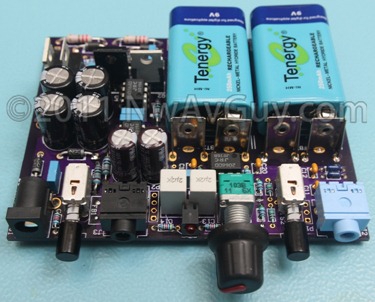 SOUND QUALITY: The O2 is a small unique headphone amp that compares well in listening tests with much more expensive gear. Are you tired of worrying if you’re getting the best sound from your headphones? Does your iPod or Clip+ fall short with your full size cans? Perhaps the portable amps you’ve tried can’t properly drive your AKG K701s? You might want to keep reading.
SOUND QUALITY: The O2 is a small unique headphone amp that compares well in listening tests with much more expensive gear. Are you tired of worrying if you’re getting the best sound from your headphones? Does your iPod or Clip+ fall short with your full size cans? Perhaps the portable amps you’ve tried can’t properly drive your AKG K701s? You might want to keep reading.
THE PROBLEM: I go into more details later but if you look at what’s available in headphone amps it’s not ideal. Very few have credible performance measurements, nearly all the portable models lack enough output for many full size headphones, the Cmoy designs are deeply flawed, many have too high of an output impedance, and the amps that get it right are generally seriously expensive.
THE (nearly) PERFECT HEADPHONE AMP: Wouldn’t it be nice to have a headphone amp that was so quiet you could use it with the most sensitive In Ear Monitors but it also had enough power to drive virtually any full size cans including 600 ohm and current hungry planar models? And, while we’re at it, what if the output impedance was low enough you didn’t have to worry about frequency response or bass damping problems? And, for maximum versatility, what if worked at home on AC power or on-the-go from rechargeable batteries? If you combine all of this with audiophile approved sound quality, switchable gain, great measurements, and a reasonable price, you have something very attractive but also highly elusive unless you’re willing to spend lots of money.
Objective Pitch
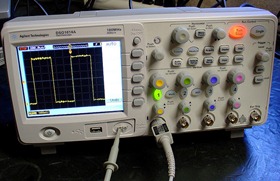 WHAT MATTERS MOST: Most of us want our gear to get out of the way so we can listen to the music as the recording engineer intended. We don’t want to listen to our headphone amp, we want to listen to the music. And if that’s the goal, the path to getting there can be summed up with one word (photo: Jeff Keyzer):
WHAT MATTERS MOST: Most of us want our gear to get out of the way so we can listen to the music as the recording engineer intended. We don’t want to listen to our headphone amp, we want to listen to the music. And if that’s the goal, the path to getting there can be summed up with one word (photo: Jeff Keyzer):
- Accuracy - ak-yer-uh-see: “The condition or quality of being true, correct, or exact”
THE ROAD TO AUDIO NIRVANA: Accuracy, and hence the best sound quality, in a headphone amp is almost entirely determined by (the non-geeks might want to skip this):
- Output Impedance – It should be less than 2 ohms to provide the correct bass damping even with 16 ohm headphones and avoid frequency response problems. Output Impedance differences account for most of the variations in sound quality people hear between different headphone amps and sources.
- Power – Sufficient voltage, current, and gain must be available to drive the desired headphones to realistic levels without strain. Many amps fall short with many headphones.
- Noise – The amp should not contribute any audible noise in real world use. Most, unfortunately have audible hiss—especially when using sensitive IEMs.
- Channel Balance – The stereo image should not audibly shift left or right with any realistic volume setting. This is another common problem.
- Frequency Response – The output should be flat to within +/- 0.1 dB from 20 hz to 20 Khz and not slew rate limited at full power. But many headphone amps, including some fairly big names like Creek and Pro-Ject, use capacitor coupled outputs that roll off the bass into low impedance loads and add distortion. Tube and single ended designs can be even worse.
- Distortion – All non-linearities (unwanted garbage added by the amp) should be under 0.01% (–80 dB) at least at midrange frequencies where the ear is most sensitive, and worst case, under 0.05% (-66 dB) across the rest of the spectrum when operating with the desired headphones and output levels. Singled-ended and tube amps nearly always fail this by a wide margin as do many conventional designs. Ideally an amp should be under 0.01% across the board.
- Transient Response & Stability – Ringing and overshoot should be tightly controlled with all realistic headphone loads. I’ve seen several amps get this wrong in their quest for needless excess bandwidth and/or excessive slew rates.
- Phase response – Less than +/- 2 degrees phase error from 100 hz to 10 Khz assures the best possible imaging and spatial perception.
VERIFIED PERFORMANCE: Unlike 99% of other amps and designs, the O2 design comes with very detailed, and verifiable, performance measurements made using professional instrumentation and industry standards. If you believe in accuracy, and listening to your music instead of your amp, the right measurements help assure you don’t have to worry about the O2 getting in the way of the music.
Subjective Pitch
PASSION, ART & EMOTION: Music is an emotional art form and some argue music reproduction is also an art. They argue there’s more to it than just numbers and science. And, even in my virtual lab coat with virtual pocket protector, I agree. But I think 99% of the art is at the very end of the signal chain—in this case the headphones. There are massive differences in the sound of different headphones. I’ve written about some of them in my HD650 Review. Much like a vintner leaves their personal signature on the wines they produce, so do headphone designers. There’s no such thing as a perfect headphone. They all measure significantly differently. And they all balance the various trade-offs differently. But in a headphone amp, you can get close enough to perfection to where the differences that remain have been demonstrated as entirely inaudible. The O2 is just such an amplifier. (photo: Kay Weller)
LISTENING TEST: The O2 was stacked up against the well regarded $1600 Benchmark DAC1 Pre in a listening challenge. The DAC1 is something of a favorite in the audiophile headphone community. A lot of subjective critics, and those who have measured it, really love it. So it’s all the more satisfying nobody has yet been able to tell the O2 from the DAC1’s headphone amp. The DAC1 Pre earned Stereophile’s top class A rating in the headphone category, a product of the year award, and countless other accolades. It has been described as “stupefyingly good” and “a revelation”. The headphones used in the comparison include the Sennheiser HD650s, Denon AH-D2000s, Etymotic ER-4s, Ultimate Ears SuperFi Pro 5s, and Beyer DT770s. Collectively they cover a wide range of impedance curves, efficiencies, types and subjective tastes in sound. The Denons and Etys are ruthlessly revealing, the HD650s are incredibly musical, the SuperFis ultra efficient, and the Beyers show off performance in the deepest bass. I hope to conduct more listening comparisons involving the O2 and perhaps even a public challenge or two. In short, I’m willing to back up my claims for the O2. Perhaps an O2 listening challenge is in your future?
PRELIMINARY FEEDBACK: Initial feedback from others has been very positive. As of September 2011 there are at least a half dozen or so O2 amps “in the wild” and feedback has been nearly all positive. One user compared the O2 to the $1000+ AMB beta22 using $1000 Audeze LCD-2 headphones and wasn’t sure he could hear any differences.
WHAT DID YOUR CABLES COST? Those who spent more on their cables than the total cost of the O2 may feel compelled to dislike it. It probably won’t matter the O2 likely outperforms whatever they’re listening to now. I’m sure many will expect more expensive, and more “esoteric”, amps to sound better. And, in the usual biased listening, their brain will likely deceive them into hearing just what they expect to hear. Some will probably brand the O2 as “sterile”, for example, because it measures well so their brain will serve up a “sterile sound” when they listen to it. This is an involuntary response (see the brain link above if you don’t believe me and check out Subjective vs Objective). So if you’re a fan of exotic cables and other expensive esoteric solutions to straightforward problems, you can probably stop reading here as you’ll be biased against the O2 from the start and only hear what you want to hear. The O2 is intended for those open to a more objective approach.
A NOTE TO BLING LOVERS: Clearly some people like bling. What their car looks like, or the name badge on the front, can be more important than how it drives. There are plenty of car, and audio manufactures, catering to such tastes. The O2, in basic form, is very big on performance but not so much on bling. To keep the price as low as possible it’s mostly function over form. DIYers, however, are free to make the O2 look as impressive as they like. They can have their high-bling cake and still feast on tasty performance. Slip the O2 into a fancy enclosure, with a big knob, expensive jacks, or whatever else suits your fancy, and nobody needs to know what’s inside.
Going Shopping
 FRUSTRATION: If you look at the headphone amps for sale, nearly all fit into one or more of these categories (photo: FreeAussieStock):
FRUSTRATION: If you look at the headphone amps for sale, nearly all fit into one or more of these categories (photo: FreeAussieStock):
- Missing Specifications - Very few amps have meaningful specs. Things like power output, frequency response, THD and crosstalk are meaningless if the load isn't specified and it almost never is. The output impedance is also a critical spec but is rarely provided. Vague specs are difficult to verify which likely means the manufacture has something to hide, or in some cases, never even properly tested their product. When such amps are properly tested they usually fall seriously short in one or more areas.
- Inadequate Output - Lots of amps, especially portable ones just don't have enough power for many headphones. The relatively popular AKG K701 is a perfect example. Most portable amps, even supposedly "high-end" ones like the AMB Mini3, can't properly drive them.
- High Output Impedance – Lots of otherwise decent amps have output impedances well above the 2 ohm limit. It’s a surprisingly common problem that causes audible frequency response errors and degraded bass performance. See the FiiO E9 review for more and also my Impedance article. Some manufactures raise the output impedance to provide short circuit protection, sometimes for stability reasons, and sometimes to try and mask other design limitations such as low frequency roll off due to capacitor coupled outputs. All the TPA6120 based amps I’m aware of have at least a 10 ohm output impedance (such as the E9 and QRV-09).
- Flavors of Cmoy – Nearly all variations of Cmoy amps suffer major limitations and/or serious problems. Most use op amps that don’t have anywhere near enough current capability for many headphones. And even into higher impedance headphones their distortion can be severe because they’re still not designed to drive anything less than 600 ohms. The dual battery versions can easily damage headphones with high levels of DC. And the single battery versions typically use very weak rail splitters or virtual grounds that further limit the output current and increase distortion.
- Single Battery or DC Wall Adapter Designs – To deliver the best performance a headphone amp needs a dual power supply but many of the more reasonably priced amps cut corners in this critical area. Headphone amps using a single battery, and/or DC wall adapter power supply are limited to using a virtual ground with all the compromises that entails, or capacitor coupled outputs which roll off the bass and add distortion, or a DC-DC converter which tends to add noise to the audio signal. While DC-DC can be made to work reasonably well, it’s mostly found in otherwise compromised amps. The other two options are typically much worse.
- eBay Amp Roulette – Shopping headphone amps on eBay is a minefield of disappointments. A lot of poorly designed amps seem to be “liquidated” on eBay where they’re unlikely to be returned and can be sold anonymously. The Cmoy I tested was a good example—it had no voltage gain. Others have high distortion, poor volume tracking, etc. I’m sure there are some decent amps to be found on eBay but the odds are stacked against you. And eBay is full of knock off products. Even if someone finds a respectable eBay amp, 3 months later it might be gone, badly cloned, or using entirely different parts. This all makes it difficult to recommend most of what’s on eBay.
- Single Ended and/or Limited NFB Amps – While these designs are hard to justify by any objective criteria, some people apparently like their added distortion, or at least buy into the hype. If you’re after the best accuracy, however, you won't find it with any single-ended amp. These amps are sort of like having someone softly murmuring in the background while you’re listening to your music. They often make their presence known rather than getting out of the way. You don’t just listen to the music, you may also forced to listen to the amp due to their higher output impedance, capacitor coupled outputs, and sometimes alarmingly high levels of distortion.
- Tube Amps – Tube amps fit in the same category as Single Ended above but usually with even more obvious flaws. Some like them for nostalgic reasons, and some like to endlessly tweak and modify them, try different tubes, etc. But, ultimately, they’re the opposite of higher accuracy. They can get in the way of your music in obvious ways--especially with more challenging headphones.
- 3 Channel Designs – I’ve shown how the supposed advantages of 3 channel designs are yet another audiophile myth. So far in my testing I’ve only seen disadvantages to 3 channel amps—some rather significant. At best they’re a waste of money and put a lot of unnecessary electronics between you and your music. At their worse they seriously degrade the audio performance. They’re the complete opposite of the monoblock concept and instead sharing lots of distortion inducing circuitry between both channels.
- Expensive – The reputable headphone amps I know of with real bipolar power supplies, suitably low distortion, low output impedance, proper grounding, enough power, etc. tend to be rather expensive. You can buy a decent brand new laptop computer for less than the least expensive amps I know of that meet the criteria. Violectric has some of the least expensive options I know of that provide detailed performance specifications.
STALE AIR: In my experience most headphone amps (and headphone DACs) fail the accuracy, or cost, criteria above. Many have a 10 ohm or higher output impedance (QRV09, FiiO E9) while others lack enough output for popular headphones (FiiO E5, E7, Mini3) And some have excessive distortion (Mini3, NuForce uDAC-2). Some have poor transient response and/or are borderline unstable (QRV09, Mini3). Amazingly, a $39 Cmoy came closest to the above goals but it still had some serious fatal flaws—especially when configured with typical gain and into low impedance loads.
FRESH AIR: The Objective2 a conventional 2 channel amp, with 2 batteries, hence the “2” in the name. But O2 also represents oxygen, and in some ways, this amp is a breath of fresh air. It has none of the limitations listed above. It simply does a very credible job of disappearing from the signal chain leaving just the music as the recording engineering intended. Some might call it “straight wire with gain”. It’s all about accuracy but not in the usual expensive audiophile overkill sort of way.
Motivation
 HOW HARD CAN IT BE? As they say on Top Gear: How hard can it be? Frustrated with commercial offerings that consistently fail with the flaws on the Going Shopping list, I wanted to prove it’s not rocket science to have your cake and eat it too. Unlike Top Gear’s comedic attempts at various challenges, I took a more objective engineering approach to designing my own headphone amp. (photo: anujpradhan.com)
HOW HARD CAN IT BE? As they say on Top Gear: How hard can it be? Frustrated with commercial offerings that consistently fail with the flaws on the Going Shopping list, I wanted to prove it’s not rocket science to have your cake and eat it too. Unlike Top Gear’s comedic attempts at various challenges, I took a more objective engineering approach to designing my own headphone amp. (photo: anujpradhan.com)
ONE SIZE FITS NEARLY ALL: There are a lot of headphone amps that work well with some headphones but not others. This is especially true for portable amps most of which can’t even drive AKG K701’s properly let alone most of the planar cans. Others have output impedance issues, too much noise for BA IEMs, etc. Rather than take the typical expensive overkill approach, I put on my engineer’s hat and took an objective approach. I established a few worst case hard-to-drive headphones and worked backwards from there (see O2 Design Process). The result is the O2 should comfortably drive most any non-electrostatic headphone your average audiophile would want to use. That includes dynamic, planar/orthodynamic, or balanced armature, from 16 ohms to 600 ohms. The O2 has 2 gain settings to help match it to different sources and headphones. And if your headphones sound better with a higher output impedance, that’s easily accommodated too.
EXOTIC COMPONENT MYTH: The O2 proves you don’t need exotic parts or esoteric circuit designs for best-in-class sound, accuracy and performance. The O2 is a fairly minimalist amp designed around the solid objective goals listed above, not subjective hype or audiophile myths (see: Subjective vs Objective). It doesn’t aim to be “warm” by rolling off the highs, try to be “sweet” by adding a bunch of distortion, or alter the bass via a higher output impedance.
CREDENTIALS CHALLENGED: This article might seem a bit more, um, “enthusiastic” than my usual reviews. And some of that is no doubt personal bias creeping in. But, truth be told, I do have a point to prove. I’ve been attacked for my “lack of credentials” in reviewing other products. It’s funny; when I give something a favorable review my credentials are rarely challenged, but if I’m critical of gear someone owns, I’m suddenly a fraud and can’t be trusted. There’s more on this rather one sided phenomena in the Subjective vs Objective article.
An Open Challenge (two of them)
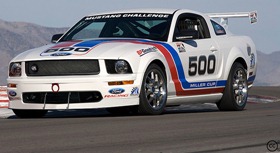 MY CRITICS: My critics have said things to the effect of “where’s your amp?” or “what have you designed?” I’ve designed plenty of things, but for various good reasons, they’re not disclosed on this blog. But the O2 is different. It was designed to fill a void in the headphone amp market driven by what I’ve learned about the audiophile headphone community since starting this blog. (photo: Ford Motor Company)
MY CRITICS: My critics have said things to the effect of “where’s your amp?” or “what have you designed?” I’ve designed plenty of things, but for various good reasons, they’re not disclosed on this blog. But the O2 is different. It was designed to fill a void in the headphone amp market driven by what I’ve learned about the audiophile headphone community since starting this blog. (photo: Ford Motor Company)
THE OBJECTIVE CHALLENGE: I’ve given my critics what they asked for and hit the ball over the net, so let’s turn the challenge around! Can anyone show me a portable headphone amp that overall objectively performs better for even triple the finished assembled price of the O2? If so, we’ll get someone independent with a real audio analyzer to test both. The O2 should be available for $150 or less fully assembled so I’ll put it up against anything up to $450. May the best amp win!
THE SUBJECTIVE CHALLENGE: Let’s raise the bar even further for all the subjective guys. For any amp that measures sufficiently well into the desired load (reasonably close to the specs outlined in the O2 Design Principals), regardless of cost, I’ll put the O2 up against it with any popular headphones within its drive capabilities. The challenger can pick the other amp, source, music, and headphones. The listening will be done blind using an A/B/X box and the comparison will be recorded on video for publication on YouTube. The test would be administered by an independent third party (I won’t even be present). The results, win or lose, will be published on this blog. And to sweeten the deal still further, if someone beats the O2 in a valid test, I’ll give $500 to the charity of their choice. If they lose, they give $500 to the charity of my choice.
COMPETITION & FAIRNESS: Raising the price/performance bar benefits consumers and that’s all I’m trying to do here. The primary goal of this blog is to get more objective information out there to help those interested better decide how to spend their money on gear. People want to buy things that live up to the manufacture‘s or designer’s claims. I’m trying to encourage manufactures to hopefully publish more and better specs and make sure their products meet those specs when properly measured..
WHERE ARE MANUFACTURE’S MEASUREMENTS? If you’re a manufacture producing a headphone amp, or even a DIY designer promoting your designs, it’s a really good idea to fully measure the performance of any amp to make sure it’s operating correctly, safe for headphones, and performs as intended. If you don’t make the right measurements, you have no idea if you got it right. So if that sort of testing is being done, why do so few manufactures publish any credible test results? It seems you have to spend $650 – $2000 for something like the Benchmark DAC1, Anedio D1, Violectric V90, etc. to get real measurements. If all the other amps perform as well as their creators claim, why can’t they publish some real evidence instead of a couple useless vague “specs”? In my opinion, they’re either not properly tested at all, or the measurements are so poor they don’t want to share them. Neither is very encouraging.
Design Highlights
A CASE FOR SIMPLE: Pointless excess is very 2007. Unlike that gold badged Cadillac Escalade that won’t fit in your neighbor’s garage, or some jacked up heatsinked monster headphone amp that looks impressive but falls over when you attempt a tricky corner at speed, the O2 was designed to be lean, mean and perform very well under real world conditions. Think of the O2 as a sort of Mazda MX-5 Miata. The Mazda is a classic design over 20 years old, that’s relatively minimalist, small, light, nimble, well engineered, amazing fun to drive, and very pure. Many find their way onto tracks on the weekend yet serve as a comfortable car for the weekday commute. There’s nothing excessive about it and it’s very reasonably priced for an open roof sports car. The current MX-5 is a lot like the original 1989 model. Mazda has admirably resisted the temptation to mess up near-perfection just trying to be trendy or by adding lots of weight and things people don’t need. It’s the same with the O2. It’s a very pure, honest, small, nimble, amp that is faithful to the music and amazing fun to listen to. And it’s largely based on proven design principals. (photo credit: Agath B)
SIMPLE O2: In the spirit of the MX-5 Miata, the O2 was designed to be as simple as possible. There are no tricky surface mount parts so no special tools or skills are required. To keep shipping costs much lower, and make things easier, all the components except the PCB and enclosure are available from Mouser Electronics in a single order. Most of the parts are very common and nearly all have Mouser substitutes if something is out of stock. There are also part numbers from worldwide distributors like Farnell. The board slips into an inexpensive all aluminum enclosure with no mounting hardware required. All the connectors and openings are along one side and require only round holes in standard drill sizes—no tricky machining required. And, to avoid any metal work completely, just send the supplied file to Front Panel Express for an inexpensive ready made front panel.
TWO BATTERIES BEAT ONE: As explained in my Virtual Grounds article, real grounds work best. The easiest, and most pure, way to a real ground in a portable headphone amp is to use two batteries. It makes the amp a bit bigger, but the single battery options are generally much less attractive and the reviews on this website back that up.
LOW BATTERY HEADPHONE PROTECTION: A significant problem with dual battery designs is what happens if one battery dies first or becomes disconnected. Under those conditions the amp could destroy your headphones with DC. The O2 uses, as far as I know, a novel approach to solving this problem. It shuts the entire amplifier down when either or both batteries start to get low or if one battery becomes disconnected. This not only prevents harmful DC at the output, it also helps protect the rechargeable batteries from being damaged by cell reversal. So with the O2 there’s zero worry about the batteries. You can safely listen until it shuts itself off.
GAIN SWITCH (added 7/24): By popular demand, the O2 now sports a front panel gain switch. This allows more optimal use with different sources and headphones of widely different sensitivities. So you can use your IEMs on the go and your power hungry big cans at home with a flick of a switch. It’s part of the One-Size-Fits-All philosophy.
DESKTOP OR PORTABLE? The default configuration of the O2 is to be as small as possible. This means 3.5 mm mini jacks, everything mounted to the PC board (nothing panel mounted), and using the enclosure shown in the photos. However, for those who want a desktop amp, you can use the next taller case (same width and depth) and the PC board slides in with room to add high quality desktop 1/4” panel-mounted jacks. See: Enclosure Options
The Project
 DIY OR COMMERCIAL? For now the O2 is a DIY project. But see the O2 Details Resources for various options, including fully assembled versions, to get one. And if you’re into DIY, you know the magic of listening to something you made with your own hands. The O2 can provide that magic. (photo: jwyg)
DIY OR COMMERCIAL? For now the O2 is a DIY project. But see the O2 Details Resources for various options, including fully assembled versions, to get one. And if you’re into DIY, you know the magic of listening to something you made with your own hands. The O2 can provide that magic. (photo: jwyg)
OPEN SOURCE HARDWARE: I don’t want to make any money from the O2. Ever. Like this blog, it’s free and here for those who want it. There are no ads, sponsors, hidden agendas, or online stores. I’m making the O2 design available to everyone under a Creative Commons License.
 This work is licensed under a Creative Commons Attribution-NoDerivs 3.0 Unported License.
This work is licensed under a Creative Commons Attribution-NoDerivs 3.0 Unported License.
THE ARTICLES: This is the first article in a series of three large articles. here’s lot more in the later two articles:
- O2 Design Process – This article covers the design methodology from setting the original goals and requirements through to arriving at more or less the final design.
- O2 Details – This covers everything else including non-DIY options, where to get parts, tips for construction, build options, etc.
- O2 Summary – This is a summary to the other articles and more.
- O2 Op Amp Measurements – Some of the op amp research that went into the O2
The (only slightly biased) Review
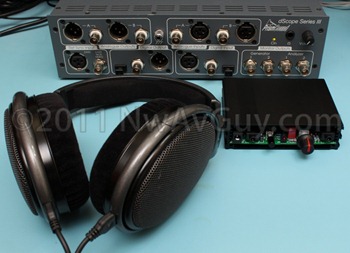 USABILITY: The O2 works pretty much like you’d expect. The batteries are charging any time it’s plugged into AC power--even while using it. It barely gets warm on AC power and not at all on battery. There’s an audible “click” at turn on (most noticeable with sensitive IEMs) and a soft “thump” on power down.
USABILITY: The O2 works pretty much like you’d expect. The batteries are charging any time it’s plugged into AC power--even while using it. It barely gets warm on AC power and not at all on battery. There’s an audible “click” at turn on (most noticeable with sensitive IEMs) and a soft “thump” on power down.
HISS & NOISE: You can’t hear any. Seriously. Even with my ultra sensitive Ultimate Ears SuperFi Pro IEMs, in the quietest room the house, at any volume setting, I couldn’t hear any noise from the O2 itself. Any noise you hear with the O2 will be from the source or an open circuit cable connected to the input. Unlike several other other amps, when you change the volume setting there’s zero noise in the headphones—even with nothing playing.
POWER SOURCE: To geek out for a moment. An often unappreciated parameter of audio circuits is PSRR—Power Supply Rejection Ratio. It’s basically the ability of the circuitry to reject noise, ripple and variations on the power supply. In a lot of discrete designs PSRR is relatively poor and it’s really awful in most single-ended amps. That makes those designs sensitive to even small amounts of noise or variations on their power supply. By comparison, you can listen to the O2 even at full volume on the high gain setting, and attach or disconnect the AC power and there’s zero noise in the headphones. The entire power supply is abruptly jumping up and down by 30% and it’s inaudible! Try that on a single-ended zero feedback and you might damage your headphones the transient at the output will be so large.
BREAK IN: Unlike typical consumer gear, and amps with capacitor coupled outputs, the O2 has no electrolytic caps in the signal path. Electrolytics, in some circumstances, benefit from being powered up a while but that’s not an issue here. So the O2 doesn’t need break-in, warm up, etc. Unlike many fully discrete designs, it’s optimally biased at any sane temperature and the IC’s quickly settle down to their ideal operating points in under a minute.
SUBJECTIVE LISTENING: The O2 is genuinely effortless, totally silent, very spacious, and never breaks a sweat with any headphones I’ve tried. It also works well with any source I’ve tried.
SUBJECTIVE COMPARISONS: I’m more than a little biased, so that’s why I broke out the blind testing gear. And, as near as I and a few others can tell so far, the O2 sounds so similar to the well regarded Benchmark DAC1 Pre’s headphone amp we can’t tell them apart. See The Subjectivist Pitch above. I also believe those currently listening to amps with significant problems, be it higher output impedance, high distortion, audible noise, insufficient power, etc, might be smiling if they try an O2. I’m looking forward to more blind tests.
BATTERY LIFE: The normal version tested here will run 7 - 9 hours and the low power version will roughly match or beat most portable players at 20 - 30 hours depending on the headphones, music, and volume. See: Low Power Version
MEASUREMENT SUMMARY: The most similar portable DIY amp I know of to compare the O2 against is the AMB Mini3 and the O2 outperforms the Mini3 on every test below. Even up against desktop-only amps, like the QRV09 and FiiO E9, the O2 does very well. Most DIY designs have no test results at all or were tested with a soundcard and the many limitations of RMAA. If you read some of my other reviews, you’ll find those RMAA numbers and claimed specs have sometimes proven to be wildly optimistic. I encourage others to verify the O2’s performance. Here’s a summary and comparison and there’s far more detailed results and comparisons in the Tech Section below:
| Measurement | O2 | QRV09 | FiiO E9 | AMB Mini3 |
| Frequency Response | +/- 0.1 dB Excellent | +/- 0.1 dB Excellent | +/- 0.1 dB Excellent | +/- 0.1 dB Excellent |
| THD 1 Khz 150 Ohms | 0.0016% Excellent | 0.002% Excellent | 0.005% Excellent | 0.002% Excellent |
| THD 1 Khz 15 Ohms | 0.0023% Excellent | 0.022% Good | 0.037% Good | 0.017% Good |
| THD 20 hz 15 Ohms | 0.0023% Excellent | 0.07% Good | 0.05% Good | 0.01% Very Good |
| THD 20 Khz 15 Ohms | 0.010% Excellent | 0.02% Very Good | 0.003% Excellent | 0.45% Poor |
| IMD CCIF 15 Ohms | 0.001% Excellent | 0.02% Good | 0.05% Good | 0.043% Fair (2) |
| IMD SMPTE | 0.002% Excellent | 0.0015% Excellent | 0.002% Excellent | 0.009% Very Good |
| Noise (ref 400 mV) | -105 dB Excellent | N/A (1) | -88 dB Fair | -94 dB Excellent |
| Max Output 15 Ohms | 337 mW Excellent | 450 mW Excellent | 1067 mW Excellent | 104 mW Excellent |
| Max Output 33 Ohms | 613 mW Excellent | 640 mW Excellent | 883 mW Excellent | 98 mW Fair |
| Max Output 150 Ohms | 355 mW Excellent | 345 mW Excellent | 317 mW Excellent | 38 mW Fair |
| Output Impedance | 0.54 Ohms Excellent | 10 Ohms Fair | 10 Ohms Fair | 0.9 Ohms Very Good |
| Crosstalk 15 Ohms | 65 dB Excellent | 67 dB Excellent | 63 dB Very Good | 40 dB Poor |
| Channel Balance | 0.6 dB Excellent | N/A (1) | 1.8 dB Fair | 1.14 dB Fair |
| Battery Life | ~8 hours / ~30 hours | AC Only | AC Only | ~5 hours |
- The QRV09 noise and channel balance measurements are not directly comparable, see QRV09 review
- Excessive sidebands, see Mini3 review
FIRST CLASS:
- Excellent measured performance on all tests
- Indistinguishable from Benchmark DAC1 Pre’s headphone output in sound quality
- Works well with nearly all headphones from 16 – 600 ohms
- Very low output impedance for best headphone compatibility
- Front panel switchable gain for best headphone & source compatibility
- Completely silent—no audible noise even with ultra efficient IEMs at any volume setting
- High Output: 7 Volts RMS & 200+ mA peak current
- Current limiting to help protect low impedance headphones from damage
- Unique battery rundown protection prevents battery & headphone damage
- Easier to build with no surface mount components
- Output impedance can be modified on board as desired (DIY)
- No volume control “rustling” (unwanted noise when changing volume settings)
- Optimal star ground and true split bipolar power supply
- Multi-stage design with local feedback improves noise, distortion and stability
- Individual output stages for each channel improves performance
- RF and DC input protection, brief short circuit output protection
- Quality components: 1% metal film resistors, poly film & low ESR caps, Alps volume control
- Fast: Slew Rate 3+ times faster than worst case requirement & bandwidth > ~250 Khz
- Compensated for maximum stability and optimized transient response
ECONOMY:
- Larger than Mini3, E5, E7, and some other portable amps
- Only 3.5mm input and output jacks by default
- Batteries take a while to charge
- Not waterproof to 50 meters
- Metal volume knob is an extra cost upgrade
- Lacks cult status to impress the subjective audio elite
BOTTOM LINE: I think the measurements speak well for the O2’s performance as do the blind listening comparisons to the Benchmark DAC1. The O2 isn’t perfect, but it’s closer to meeting all the goals than anything else I’m aware of for up to several times its price. If there’s any amp I’ve missed, especially a portable one, that can give the O2 a run for its money, please let me know? For those seeking maximum performance for their dollar, the Objective2 is worth considering. And the Creative Commons license opens up commercial possibilities for other people (not me) to profit from it. And if someone accepts my earlier challenge, and does come up with a better amp for the money, then everyone wins. My entire goal was to raise the bar and show what can be done with solid engineering, proper implementation, and cost-optimized components.
WHAT’S NEXT: This article introduces the O2 and documents its performance. I have written a follow up article that addresses the design process while O2 Details covers everything else including links to several other O2 resources and the design documents (schematic, BOM, board layout, etc.). As always, comments and feedback are encouraged.
COMMENTS & FEEDBACK: As I’m banned from Head-Fi I won’t be able to discuss the O2 there. The official threads for this amp are:
- O2 on diyAudio – This is the best place for the DIY crowd to discuss building the O2, creative enclosures, add-ons, etc.
- O2 on ABI – AnythingButiPod is a great friendly site and it’s the best place for non-DIYers to discuss the O2. The more hardcore DIY guys are probably better off at diyAudio.
Measurements (aka Tech Section)
TECH INTRO: In a normal review I would discuss the design details in this section. For this already long article, to keep things manageable, I’m presenting just the measurements. To provide some context, I’ve made many comparisons to the O2’s closest DIY competitor--the Mini3. There are also a few graphs for the FiiO E9, QRV09, and Benchmark DAC1’s headphone output. All the comparative data makes this section longer than normal but hopefully more interesting and useful.
FREQUENCY RESPONSE: The overall response is +/- 0.07 dB from 10 hz to 48 Khz. Both channels are shown into 150 ohms. The O2 has a DC blocking capacitor to reduce the O2’s own DC offset and prevent DC offset at the input from being amplified which could potentially harm headphones. There’s a very slight, and very inaudible low-frequency roll of –.04 dB at 20 hz. The –3 dB point is just above DC at 1.8hz. The O2’s transient response has been optimized using additional compensation which results in the response being down a trivial 0.01 dB at 48 Khz and a – 3 dB point of about 250 Khz. At full volume, the channel matching is excellent (< 0.005 dB):
OUTPUT IMPEDANCE: With 400 mV RMS unloaded a 15 ohm load reduces the output to 386 mV giving an output impedance of 0.54 ohms. This is excellent performance and well under my 2 ohm rule of thumb.
NOISE & VOLUME CONTROLS (and some myth busting): One of the big claims for many audiophile op amps is lower noise. The chip manufactures make a big deal about it and audiophiles, not surprisingly, have jumped on the bandwagon. But, in reality, it’s often the Johnson Noise that limits the noise performance of a headphone amp, not the op amps. Johnson Noise is, literally, self generated noise that’s present in any resistor. The larger the resistor value, the more noise you get. Many DIY headphone amp designs have the volume control at the input to the gain stage. And it’s, at the lowest, usually 10,000 ohms. By comparison the O2 has 274 ohms in series with the input. That’s a huge difference in Johnson Noise. The way volume controls work, the noise is typically worst at half volume where you have 5000 ohms in series with the source and 5000 ohms to ground. So, at typical volume settings, you get a fair amount of Johnson Noise from the volume control that’s amplified by whatever gain your amp has. That noise typically exceeds the op amp’s internal noise. If you put the volume control after the gain stage its Johnson Noise is no longer amplified. And, as a bonus, the volume control at lower settings now attenuates noise from the gain stage. For more, see O2 Circuit Description and Circuit Design.
NEW NOISE REFERENCE: I’ve used 400 mV as my reference level instead of the more typical industry standards of dBV (1 volt RMS) or dBU (775 mV) because a lot of portable gear can’t output anything over 500 mV. But, it’s easy enough to adjust noise figures to different references. So, where applicable, I’m going to to use the industry standard dBV for noise measurements from here forward. To convert dBV to my previous 400 mV dBr values, subtract 8 dB. To convert from 400 mV to dBV just add 8 dB. The dScope reads in dBV directly. It also makes it easier to compare my data to the data published by others.
O2 NOISE: The final version 1.1 O2, using dBV (referenced to 1 V RMS), measures nearly –112 dB unweighted and –115 dB with A-weighting. Referenced to 400 mv that’s –104 dBr and –107 dBr respectively. And note this is at full volume which is the worst case scenario for the O2. This is several dB quieter than even the QRV09 which uses an extremely high end op amp and doesn’t even have a volume control. In fact it’s quieter than any headphone amp I’ve measured:
NOISE AT HALF VOLUME: Most amps, like the Mini3 and E9, have more noise at half volume (due to Johnson Noise) which is a more realistic setting for real world use. The V1.1 O2, however, is actually quieter at half volume. To put these numbers in perspective, referenced to the old 400 mV they’re –105.3 dBr and –108.2 dBr. On the exact same test, at half volume, the Mini3 had nearly 11 dB more noise and measured –94.5 and –97.5 dB. Noise of –113 dB below 1 volt is under 3 microvolts of absolute noise or 0.000003 volts. For more on noise see: Noise and Dynamic Range. The O2 is an extremely quiet headphone amp:
NOISE ON AC POWER: So how does the O2 measure up on AC power? The graph below is the answer—it’s not much different than the battery graphs above:
BENCHMARK DAC1 PRE NOISE: For comparison, here’s the DAC1 at half volume via the analog input referenced to 400 mV so you have to subtract -8 dB and get –108.1 and –113.6 dB. Both about 4 dB more noise than the O2! All the extra noise spikes are due to the digital circuitry, and internal power supply, in the DAC1. I’m sure John Siau and crew at Benchmark Media, however, could match or beat my design if they did a similar analog-only amp with a remote power supply. So this isn’t entirely a fair comparison:
NOISE MARKETING STYLE: The marketing guys usually reference their noise specs to full output. With the O2 that’s around 7 volts. So here’s the exact same test above referenced to 7 volts. The weighted result approaches the –135 dB ultimate noise limit of the dScope! This test demonstrates the O2’s dynamic range:
REAL ENGINEERING vs INTUITIVE DESIGN: Intuitively an amateur designer could easily be excused for believing ultra-low noise expensive op amps are the best way to design a silent amp. But the O2 doesn’t use ultra-anything. This is an example of what I’ve been saying since I started this blog: Implementation is everything and usually far more important than the part number or brand logo on top of the components. The numbers above are a very significant 11 dB better than the Mini3’s more fashionable and more expensive Analog Devices op amp. The difference is in the implementation and design.
THD+N vs OUTPUT & MAX POWER ON AC: At 1 Khz with both channels driven here’s the distortion versus output on AC power into 15, 33, 80, 150 and 600 ohms. At 150 & 600 Ohms the output voltage was essentially the same at about 7.3 volts RMS. And even at about 200 mW of output into any of the loads the distortion is still below about 0.0025%! Maximum power is about 640 mW at 80 ohms. The power limits shown below exceed the power requirements established for the assumed worst case headphones (HiFiMan planars and 600 ohm version of the Beyer DT880):
ACTIVE CURRENT LIMITING: Say you’ve had far too much to drink some evening, you’re listening to your expensive low impedance headphones, and a favorite song starts playing. If you’re listening to one of those “over kill” amps, or even the FiiO E9 that can put out 1 watt, you may well be out several hundred dollars when in your drunken enthusiasm, you crank the volume too high. The O2 tries to prevent such accidents with intelligent current limiting. Instead of throwing a big resistor in series with headphone jack, as many amps do ruining the output impedance, current limiting makes a lot more sense. It allows maintaining a near-zero output impedance and still limits power into lower impedance loads. For those who think it compromises sound quality, the O2 measurements speak for themselves as do the blind listening tests. 166 mA was the target goal to drive nearly any headphone and the O2 doesn’t limit until around 200 mA. So in real world use you won’t get anywhere close to triggering the current limiting. It only comes into play to help protect the output stage and headphones from accidents.
THD+N vs OUTPUT & MAX POWER ON BATTERY: Here’s the O2 running on battery power with both channels driven into 15, 33, 80, 150 and 600 ohm loads. Power is still over 500 mW per channel into 33 ohms for those power hungry planar/orthodynamic cans and the distortion is very similar to the AC performance into all loads (note the horizontal scale is different than above). The power into 15 ohms is roughly the same as on AC due to the current limiting. The batteries were at about 80% charge here (9 volts under load) and the O2 manages +/- 7.5 volts into 600 ohms which is respectably close to the rails. This is the best overall performance I’ve seen from any battery powered amp:
O2 THD+N SWEEP vs AMB MINI3: Here’s both amps at 15 and 150 Ohms running on battery power with the Mini3 shown in pink (15 ohms) and white (150 ohms). Note the O2 produces nearly ten times the power into 150 ohms and over triple the power into 15 ohms. The lack of a shared virtual ground helps the O2 both put out more power and do so at much lower distortion. AMB has said the Mini3 is suitable for 16 ohm loads as long as you don’t “overdrive it”. And the site claims the OPA690 virtual ground can handle 190 mA of current. But even going easy on the Mini3, at only 800 mV of output, it has fifty times more distortion than the O2 (0.1% vs 0.002%). This isn’t “overdriving” the Mini3 as 800 mV is a realistic level many portables can achieve without an amp, and results in only 75 mA per channel of peak current per channel or 150 mA total. This is comfortably within the specs for the OPA690 in the Mini3. If you look at the graph below, at any level into either impedance, the Mini3’s virtual ground is helping making things worse instead of better (note this graph starts at zero instead of 10 mv so the extreme left shows more interpolation error):
THD+N vs FREQUENCY 400 mV: Instead of distortion versus output power above, this is distortion versus frequency across the audio spectrum at a constant 400 mV RMS with the latest V1.1 design. The traces are, top to bottom, 16 (the “16” in the caption is a typo), 33, 80, and 150 ohms. At 150 ohms you can see the distortion is generally extremely low around 0.0009% across most of the band and essentially flat with frequency. 80 ohms is almost identical. At 33 ohms, the distortion is still only about 0.0015% across the band. And into a difficult 15 ohms the distortion is still around 0.003% – 0.004%. The NJM4556 is really showing off here. This is amazing performance for a $0.60 IC into 15 ohms! The THD bandwidth is limited to the audible range (22 Khz) as that’s the industry standard. This causes the traces to drop at the top end where arguably inaudible ultrasonic harmonics are filtered out by the analyzer: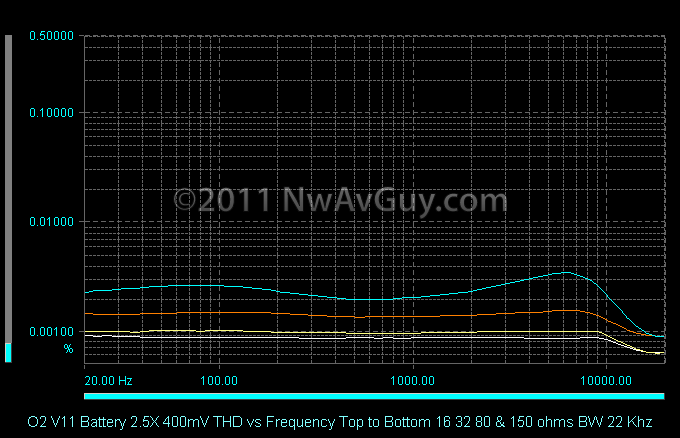
WIDEBAND THD+N SWEEP: Some have asked what happens if you remove the 22 Khz bandwidth limit of the audio analyzer to let the ultrasonic harmonics be included in the measurement. Here’s the above test repeated, at 80 ohms, but at the full bandwidth of the analyzer (192 Khz sampling). The overall distortion is slightly higher as that’s really the higher “noise floor” from the analyzer adding in all the noise above 22 Khz. Still, the distortion barely crosses 0.002% at 20 Khz:
THD+N vs FREQUENCY 6.0 Vrms: Ok, the O2 looks good at my standard level of 400 mV for this test, but what about pushing it to nearly the limit at 6 volts RMS? There are not many (any?) headphones under 150 ohms that need that much voltage. Into 150 ohms the O2 is putting out 250 mW per channel or half a watt with both channels. Even at this hefty power level the distortion is still below 0.002% across the entire band:
FiiO E9 THD SWEEP COMPARISON: Here’s the O2 vs the FiiO E9. Into 150 Ohms they’re both good but the O2 has about half the distortion of the TPA6120-based E9 across the entire spectrum. Into 15 ohms the O2 kills the FiiO E9 below about 4 Khz. The O2 is the clear winner here:
BENCHMARK THD COMPARISON: Here’s the Benchmark at only 15 ohms as any higher impedance is about the same. That’s because, at 400 mV, noise dominates the THD+N measurement on the DAC1, not distortion. Regardless, the O2’s performance is very much in the same league with both below 0.003% in either either load across the band:
THD+N 150 OHMS WIDE SPECTRUM: Here’s the wideband THD+N measured to 80 Khz, both channels into 150 ohms at 400 mV on AC power. THD+N of 0.0016% is excellent and slightly lower than the expensive op amp in the Mini3 managed. The worst distortion product is below an impressive –108 dB. Note the THD+N is nearly identical in both channels. This indicates the PCB layout is electrically symmetrical. The –115 dB spike at 60 hz is also very inaudible. The readings and spectrum in this test are so similar on AC and battery it’s hard to tell them apart. There’s nothing to fault here:
BENCHMARK COMPARISON: Here’s the DAC1 for comparison with the same test as above. It has about twice as much THD+N but most of it is just noise from all the nearby digital circuitry not actual distortion:
LOW LEVEL THD & THD+N: The THD+N vs output sweeps above make it look like the O2 has lots of distortion at low levels. But that’s not the case. The sweep points are averaged and interpolated. And because the sweep is starting at zero volts where the THD+N is essentially 100% (all noise no signal) it skews the result into looking worse than it really is. Here’s the THD+N and THD readings at the same 1 Khz referenced to the same 400 mV but with the amp only putting out 10 mV to simulate low level listening. Note the THD reading is only 0.0019%. Everything else that goes into the 0.03% THD+N reading is just noise which, relatively, is a much greater portion of the measurement when the signal is this low. This is excellent performance:
THD+N 15 OHMS SPECTRUM: A lot of amps struggle with this test as it’s a much more challenging 15 ohm load. But the O2 aces it with everything well below an impressive –94 dB. The Mini3, in comparison, failed with the 3rd harmonic at about –75 dB. The THD+N and THD readings are nearly the same because the noise floor is so low:
THD RESIDUAL 15 OHMS: The main idea behind power hungry Class-A amps is to get rid of a particularly objectionable form of distortion known as crossover distortion. Crossover distortion shows up in this test as an obvious large spike or “glitch” in the blue waveform where the yellow waveform crosses through zero (see the Mini3 for an example). It’s very common, and sometimes rather severe, in headphone amps that use discrete output transistors unless it’s a true class-A design. This is the best of both worlds. Class-A performance with zero visible crossover distortion on a Class-B power budget even into a challenging 15 ohms and less than 7 uV RMS of distortion residual:
INPUT OVERLOAD ON BATTERY – Here’s the V1.1 O2 running on batteries at about 80% charge. The battery voltage was 9.2V. At 2.5X gain it can still handle a 2 volt RMS input signal, which is the Redbook standard for home digital audio equipment. On AC power it can handle 2.8 V RMS which is well in excess of the FiiO E9 which overloads at 2.1V input. So even on reasonably charged batteries the O2 is fine on battery power:
INPUT OVERLOAD ON AC – Here’s the V1.1 O2 running on AC power with 2.9 V RMS in at 2.5X gain and half volume. The uniform distortion products are a sign the input stage is just under clipping but the THD+N is still a respectable 0.0074% and everything is way under the magic –80 dB point:
VOLUME CONTROL MYTH BUSTING: While the volume setting can make a difference, mostly with noise measurements, it’s usually not the dominant factor in most amplifier performance tests—especially at 1 Khz or below. Some of my critics argued my Mini3 review was flawed because I used a volume setting of 50%. So here’s the exact same test as earlier, repeated with the volume set to 50% and the input signal raised to get the same 400 mV at the output. The distortion actually went down by an insignificant amount (likely in part due to lower noise). In other words, it’s virtually the same if not better at 50%. Another myth busted:
THD 20 KHZ 150 OHMS: With the volume at 50%, here’s the 20 Khz result measured out to 88 Khz. Note the worst distortion product is about –93 dB. This is excellent performance (the V1.0 and V1.1 boards tested the same):
THD 20 KHZ 15 OHMS: 15 ohms at 20 Khz with a THD measurement bandwidth out to 88 Khz is genuinely challenging and includes the ultrasonic region. And the O2 still does very well barely staying under the magic –80 dB mark across the board. By comparison, despite the realistic level of only 400 mV, the Mini3 did very poorly on this test with a reading of 0.45%—or 27 times more distortion. The FiiO E7 was also higher at 0.056%. The O2 is edged out here by the QRV09 which rocked this test with 0.003%. The TPA6120 in the QRV09 does a great job at high frequencies into low impedance loads. But, the TPA6120 (also used in the FiiO E9) has other problems as seen earlier in the sweep comparison. There’s also theTI mandated 10 ohm minimum output impedance. The O2 has zero audible problems here (the V1.0 and V1.1 boards tested the same):
THD 20 HZ 15 OHMS: I skipped the 150 Ohms 20 hz test as it approached the noise floor of the dScope itself. But at a challenging 15 ohms at least there’s something to see even if it only adds up to 0.0023% THD+N. Everything here is well below –90 dB. For comparison, the QRV09 and E9 di much worse here with about 30 times more distortion than the O2. The Mini3 came in at 0.01%—about 4 times higher. This is excellent performance (the V1.0 and V1.1 boards tested the same):
IMD CCIF 150 OHMS: Many think this is a more revealing test than simple high frequency THD. Some amps really make a mess of it and create a lot of distortion products within the audible band. Like nearly all my tests, this one is run with both channels driven at 400 mV. As with the other tests, you ideally want everything but the two signals (at 19 Khz and 20 Khz) below –80 dB (or –66 dB depending). The O2 does far better with everything in the audio band below about –102 dB including the sidebands (the V1.0 and V1.1 boards tested the same):
IMD CCIF 15 OHMS: This is one of the most challenging tests I run. Every single amp and device so far has failed the “-80 dB rule” with something over that level. The Mini3 had a very difficult time with this test as did the uDac-2. Even the TPA6120 QRV09 and FiiO E9 had the 1 Khz component, right where the ear is most sensitive, well over –80 dB. In comparison, the O2 passes this tough test with flying colors. Even the ultrasonic components are below –80 dB (the V1.0 and V1.1 boards tested the same):
MINI3 IMD CCIF 15 OHMS: To put the above performance in perspective, here’s the Mini3 on the same test, same 400 mV, same load. Notice the sideband that reach almost –50 dB. These are almost certainly audible:
IMD SMPTE 150 OHMS: Not much to see here. Everything is below about –110 dB:
IMD SMPTE 15 OHMS: This is also a very good result with everything below –90 dB. The QRV09 and E9 both crossed the –80 dB line on this test and the Mini3’s reading was about 4 times higher (the V1.0 and V1.1 boards tested the same):
INTERCHANNEL IMD BASELINE: While testing the Mini3 I found its shared virtual ground (“3rd channel”) was causing a lot of problems. I devised a test to show some of these problems more clearly. I operated the measured channel at 1 Khz and the other channel at 300 hz with both at 1 volt into 15 ohms. Even though the combined peak current was within the claimed current capabilities of the shared virtual ground, it created a “forest” of ugly relatively high level distortion products. First, here’s the O2 with one channel driven into 15 ohms at the same 1 volt. This is the baseline and the residual noise figure of –100.5 dB (which excludes the 1 Khz signal and its harmonics) shows there isn’t much else going on (the V1.0 and V1.1 boards tested the same):
INTERCHANNEL IMD: Here’s the same test but now the other (unseen) channel is also driven to 1 volt into 15 ohms but at 300 hz—a different frequency in each channel. There’s the expected 300 hz signal at –64 dB which is the expected crosstalk into 15 ohms (more on that below). But the important thing to note is the rest of the spectrum isn’t much different than the one above. The residual noise figure, which is the sum of everything not related to the 1 Khz signal, reflects only the expected crosstalk at 300 hz. The two different signals don’t interact in ugly ways via the common virtual ground like they do in the Mini3. There’s virtually no extra non-linearities here. This is important as there are good reasons to believe non-linear interchannel distortion could be much more audible that the usual variety. This is explained more in the Mini3 review and 3 Channel articles. This result is also important to prove a point. I’m still getting messages from people defending 3 channel designs as being objectively better. So there’s a bit of an axe to grind here. The main premise for 3 channel designs is the headphone currents (which are relatively high here at about 94 mA peak per channel) “pollute” the power supply rails and the input ground circuitry. Some have shown scary looking simulations, talked about power supply capacitor ESR, etc. This is a class B amp. So all those non-linear currents should be “polluting” the O2 and causing problems if you buy into the 3 channel argument. But that’s not the case. If the alleged “pollution” were a real world problem there would be a much bigger mess in the graph below. The only significant “leakage” is the linear (not a form of distortion) crosstalk from the other channel and that’s the fault of the headphone jack, not the real ground. With a 4 wire headphone connection it would be more like –95 dB. These results, and everything else I’ve shown, hopefully put the 3 channel myth to rest. It’s based on a false premise that’s best addressed with a proper star ground. And, regardless, the much greater negative side effects of a virtual ground far outweigh any supposed benefits. Here’s yet more evidence (also see the Cmoy review):
MINI3 INTERCHANNEL IMD COMPARISON: Here’s the exact same test on the Mini3. Note the “forest” of non-linear distortion products created by the virtual ground amp:
CHANNEL SEPARATION (CROSSTALK): This has been another bone of contention with the 3 channel fans. The claim is a virtual ground makes for lower (better) crosstalk but that’s not what I measured on the Mini3 and in fact it’s also not what basic circuit theory would predict. AMB claims a measured –88 dB crosstalk at 33 ohms for the Mini3. But I’ve provided the math (see the Mini3 review) showing that would require a ground impedance of only 1.3 milliohms (0.0013 ohms) which is, for many reasons, quite impossible. I measured –46 dB at 33 ohms for the Mini3 which has since been verified by a former Mini3 fan. It’s the Mini3’s actual crosstalk and mainly the virtual ground is responsible for the poor result. By comparison, using a real star ground, the O2 measures a much better –72 dB (below) at 33 ohms. And that’s almost entirely caused by the 3.5 mm jack and plug. It would be better than –95 dB (at 1 Khz) using a 4 wire connection. The O2’s crosstalk, top to bottom, at 15, 33, 150 and 600 ohms is shown below. At 1 Khz, with the volume at 100%, the O2 measured about –65 dB, –72 dB, –91 dB and –95 dB respectively. This is similar to the also excellent QRV09 which didn’t even have a volume control. At 600 ohms, above about 5 Khz, you can see other aspects of the design besides the output ground impedance contributing to the crosstalk. This is literally as good as it gets with a typical 3.5 mm jack and plug:
CHANNEL SEPARATION (CROSSTALK) VOLUME=50%: Part of the Mini3 crosstalk debate centered around the volume control setting. My critics claimed the Mini3’s crosstalk would have met AMB’s claims at full volume. So to show what effect the volume control has, here’s the O2 at half volume (yellow) and full volume (blue) into 150 ohms: At 1 Khz the volume control degrades the crosstalk only 2.4 dB to –88.9 dB. Note how the performance below 1 Khz is virtually identical. Above 1 Khz the capacitive coupling between the left and right sections of the volume control (and to some degree other parts of the circuit) increasingly affects the measurement. With the Mini3, the crosstalk was poor all the way down to 5 hz. The O2’s crosstalk, at any frequency, is around 20 dB better than Mini3 with both at the same 50% volume setting. So on a completely level playing field, even into a virtual-ground-friendly 150 ohms, at only 400 mV of output, the virtual ground is inferior by a wide margin. It’s an apples-to-apples comparison and I’m not even remotely “overdriving” the Mini3. This is just the advantage of a real ground compared to using an op amp as a common ground. Please see the Mini3 review and comments for the math if you’re still in doubt (the V1.0 and V1.1 boards tested the same):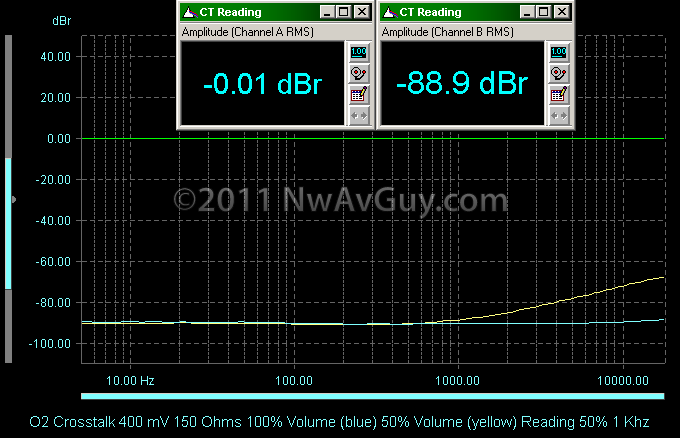
PHASE: The O2 provides correct absolute phase (it does not invert the signal). The phase response may not be as ruler flat as some amps I’ve tested, but that’s by design. The O2 has DC protection and better transient response as a result. It’s off by less than 0.8 degrees at 10 Khz and about the same amount at 100 hz. This means the phase is extremely accurate through the bulk of the audio spectrum containing spatial information. There’s very little spatial information below 100 hz and 5 degrees at 20 hz is still trivial and better than the 8 degrees of the QRV09. The low frequency phase shift is from the –3db point of 1.8 hz using the largest value high quality film capacitor that would fit in the small enclosure rather than an inferior (but higher value) electrolytic. Above 10 Khz the rest of the signal chain, especially the DAC output filter, probably has a much larger phase shift than the O2. The very slight HF shift in the O2 is from the added compensation and transient optimization (-3 dB at ~250 Khz):
ADJUSTABLE GAIN: The default low gain setting for the O2 is ~2.5X (~8 dB) for use with typical headphones and/or high output home sources. And at the high gain setting it’s ~6.5X (~16 dB) for low output sources or high impedance headphones needing lots of voltage. See Gain Settings and All About Gain. The graph below shows the final V1.1 O2 at the default gains. You can see there’s only a very slight increase in distortion switching to 6.5X gain part of which is likely just the noise floor:
CHANNEL BALANCE: The O2’s Alps volume pot, which is essentially the same one used in the Benchmark DAC1, tracks impressively well. I usually only measure down to –45 dB (shown in the graph) as below that things tend to get ugly. But here the O2 is still well under 1 dB error even at –55 dB (which is really quiet for any sane gain configuration)! Note this is the “3B” taper which should score worse for low level channel balance. For comparison, the FiiO E9 has 1.8 dB of error at –45 dB:
CLIPPING PERFORMANCE: Some amps become unstable when pushed to clipping for many reasons. Some op amps, for example, are prone to phase reversal when clipped where the output violently slams into the opposite supply rail. Other amps exhibit ultrasonic oscillation when clipped. The O2 is completely clean into any load I tried and also exhibits very close to symmetrical clipping. This is one of those tests everyone should always run, and not just with a soundcard “scope”, so you can see any ultrasonic/RF problems. Here the O2 hits +/- 20 volts peak-to-peak at 10 Khz into 600 ohms on AC power on a 100 Mhz scope:
SQUARE WAVE PERFORMANCE: Here’s a 2 volt p-p 10 Khz square wave into real world Sennheiser CX300 headphones. Note the complete lack of overshoot or ringing and the relatively square edges of the waveform. This is due to the dominant pole compensation being optimized for the best transient response. The little bits of noise on the horizontal parts of the waveform is noise from the 2 GS/sec 8 bit A/D in the scope not the O2:
CAPACITIVE LOAD STABILITY: Here’s the exact same test as above, but with an added 0.01 uF of capacitance (headphones + capacitor in parallel). Note the rise time is slightly slower but it’s otherwise completely stable with no overshoot or ringing:
SLEW RATE: Here’s a greatly “zoomed in” view of the same 10 Khz square wave but this time into 600 ohms at just under clipping. This is on a different scope that’s useful because it gives the difference in voltage and time for any two arbitrary points on the waveform. In the last column of the measurements at the top you can see between points 1 and 2 on the waveform it covered 12.65 volts in 3.51 uS. This gives a slew rate of 3.6 V/uS. By the industry rule of thumb, the O2 only needs a slew rate of 1.4 V/uS and the spec generously calls out 3 V uS. So, bottom line, this amp will never slew rate limit, even at full output, with any digital music you can feed it. There can be ugly side effects associated with excess slew rate. The megahertz region instability seen on the Mini3 with this same test is likely just such a side effect.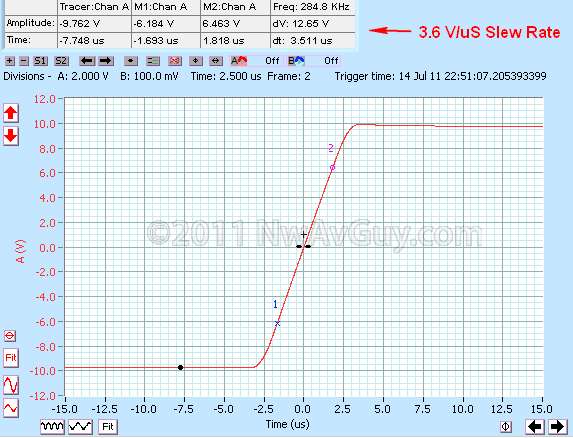
SQUARE WAVE RISE TIME: This is essentially the same test as above, same 20 V p-p, same 600 ohms, but on my Agilent scope which does the industry standard risetime calculation using the 10% and 90% points on the waveform. So the signal went from –8 volts to + 8 volts in 4.6 uS which gives a 3.5 V/uS full power slew rate very similar to the 3.6 V/uS measured above:
DC OFFSET: The V1.0 DC offset measures 2.8 mV in one channel and 2.7 mV in the other which is insignificant. The V1.1 board measured 3.0 mV and 3.1 mV.
THE FINE PRINT: Unless otherwise specified all tests are the default configuration at 2.5X gain, with both channels driven into the specified load at 50% volume. Most graphs indicate “AC” or “Batt” documenting the power source used. The WAU16-400 wall adapter was used for the AC tests and Nexcell 200 mAH “EnergyOn” (V1.0) and Tenergy 200 mAH and 250 mAH (V1.1) 8.4 V NiMH batteries were used for the battery tests. Maximum power output in the battery powered tests varies a bit due to battery charge level and the different batteries. The driving source and measurement instrument, unless otherwise noted, was a Prism Sound dScope III running V1.4d software. The dScope’s output impedance is 25 ohms. For more on my measurements, please see Testing Methods.
VERIFICATION OF MEASUREMENTS: I’m hoping to have the O2’s more critical measurements verified by someone independent with an Audio Precision, dScope, or similar equipment. If there are any measurements anyone is especially suspicious of, please let me know so I can make sure they are verified.
TECH SECTION SUMMARY: I won’t keep repeating myself except to say I’m very pleased with the O2’s measurements and I’m not aware of any portable amp, especially with the O2’s output voltage and current capability, that can beat it at for anywhere even close to the price. The next article covers the design process while the O2 Details covers everything else. It’s a lot to read but hopefully the headings will help folks skip the stuff they don’t really care about.
 This work is licensed under a Creative Commons Attribution-NoDerivs 3.0 Unported License.
This work is licensed under a Creative Commons Attribution-NoDerivs 3.0 Unported License.

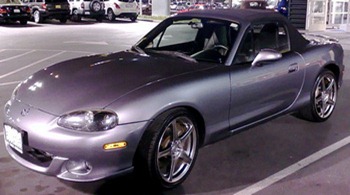
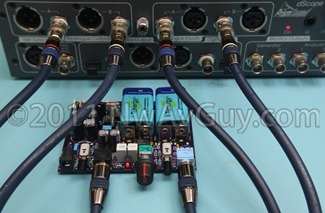
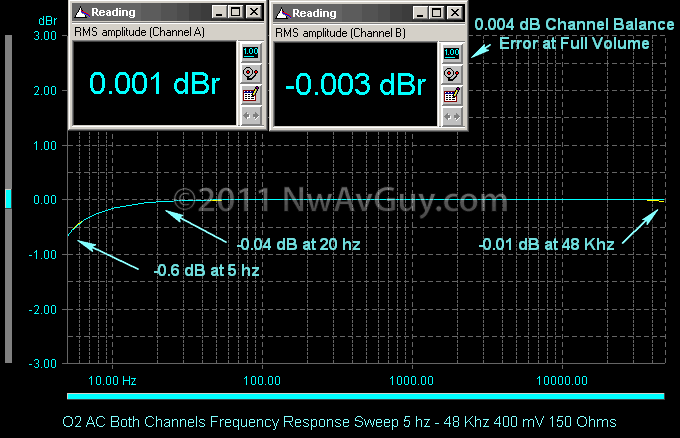
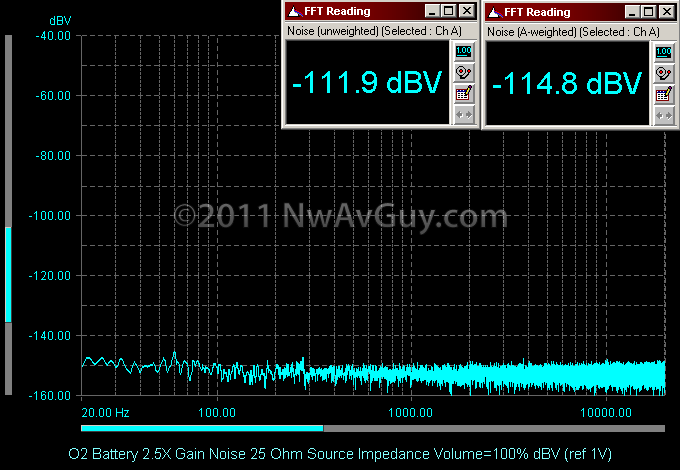

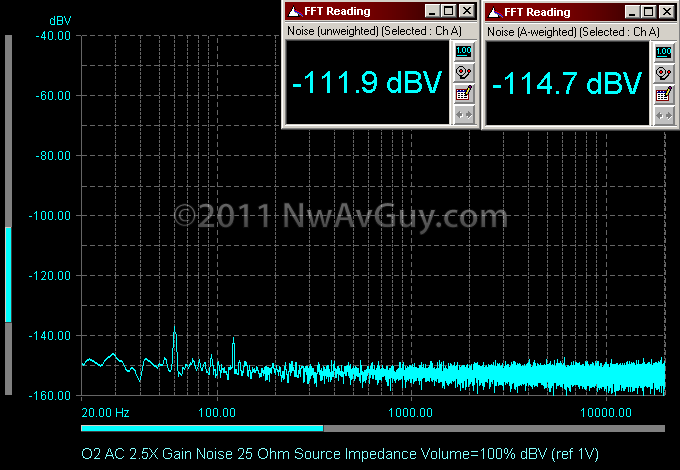

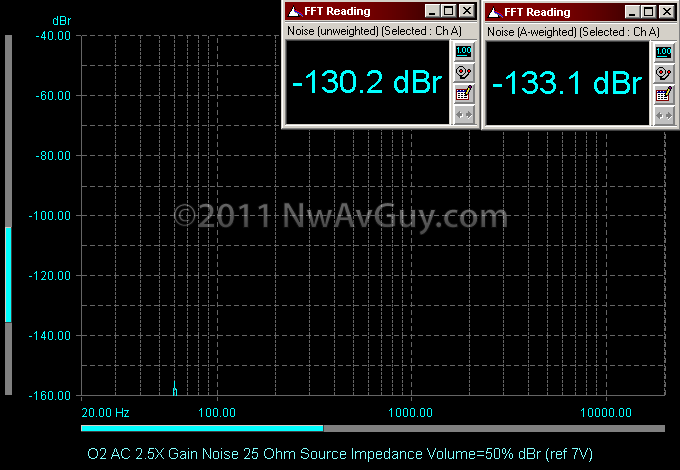
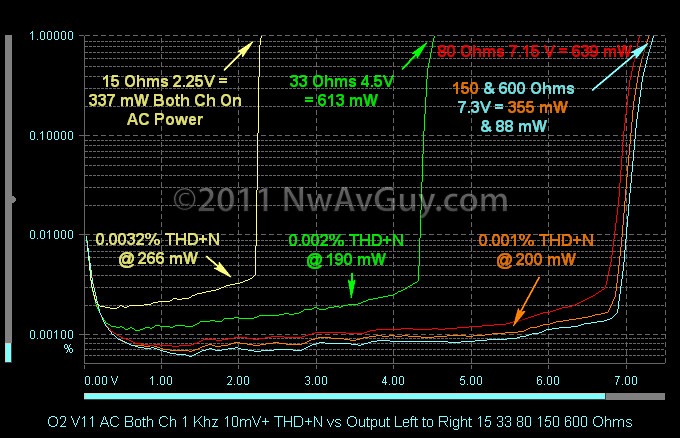
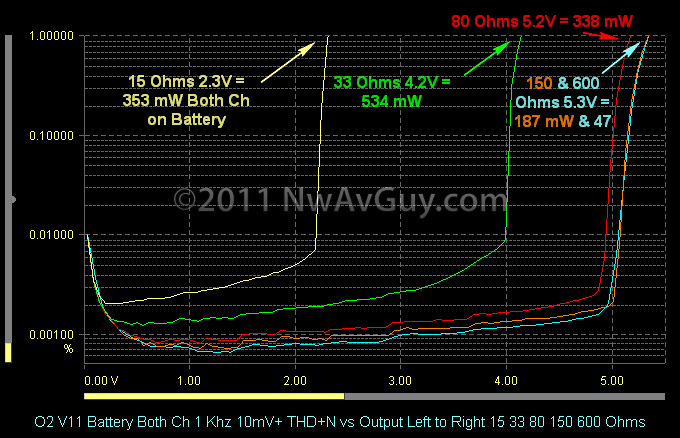

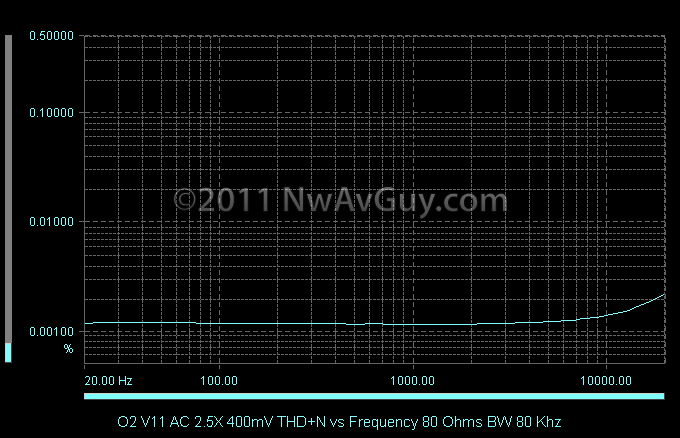
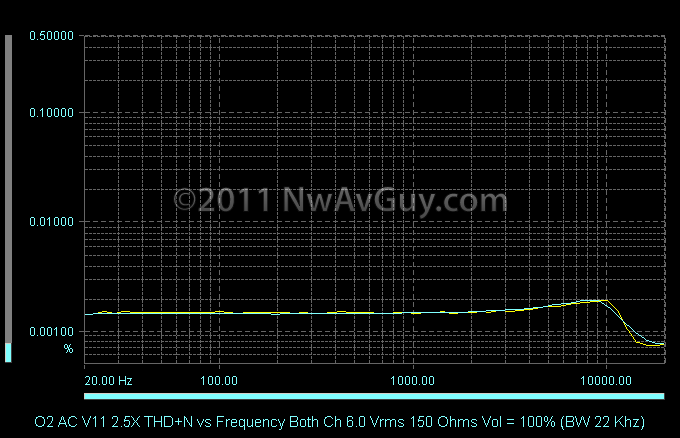
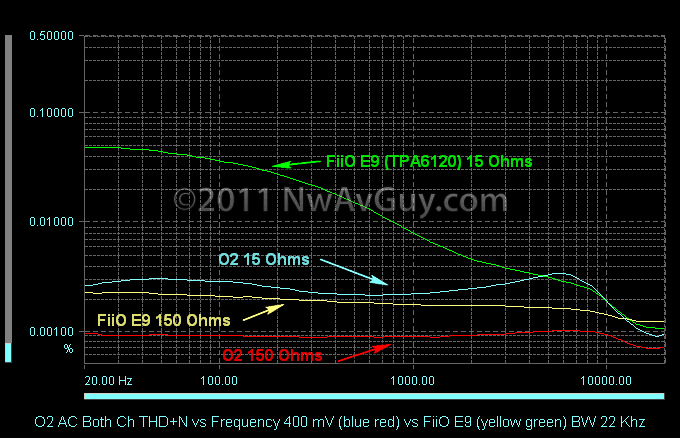

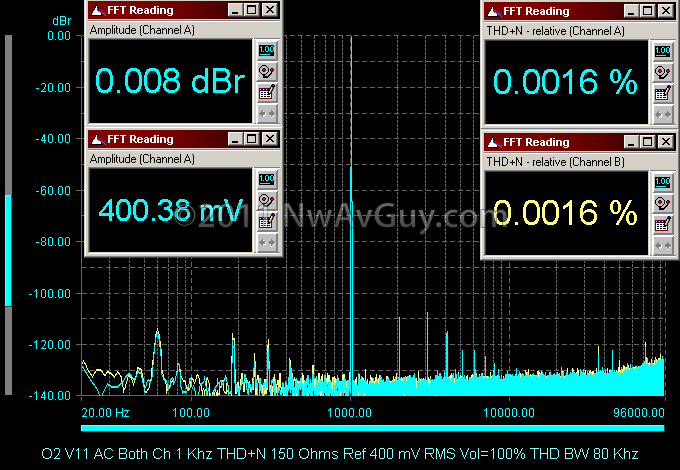
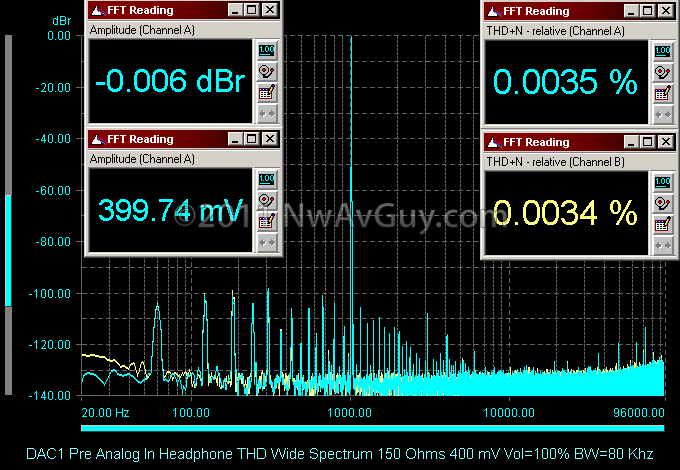
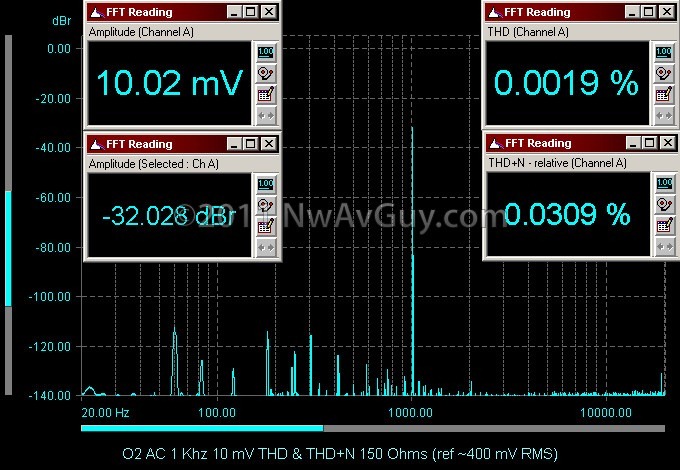
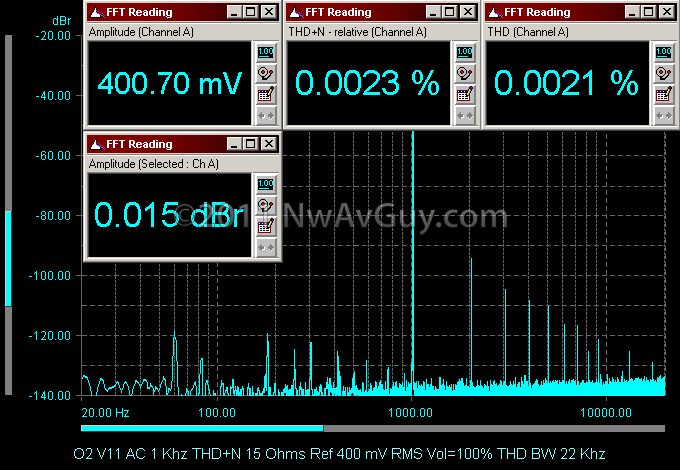

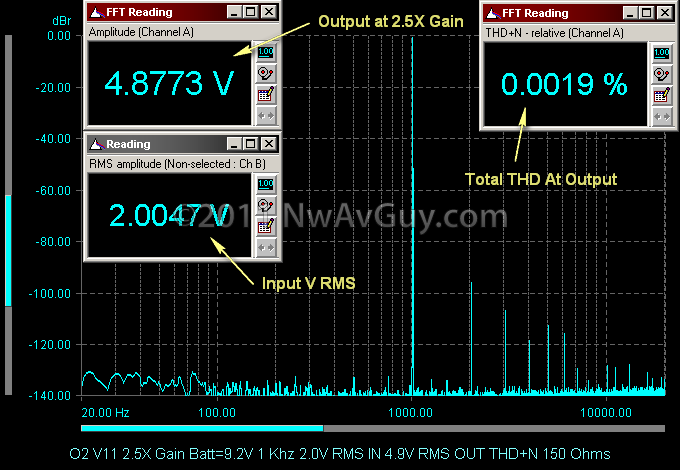
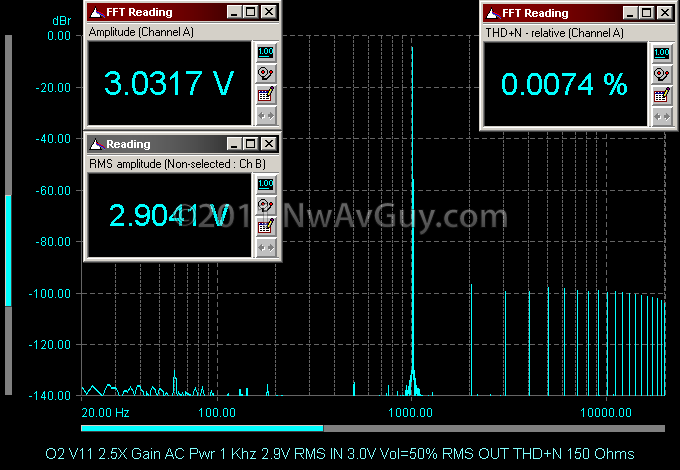


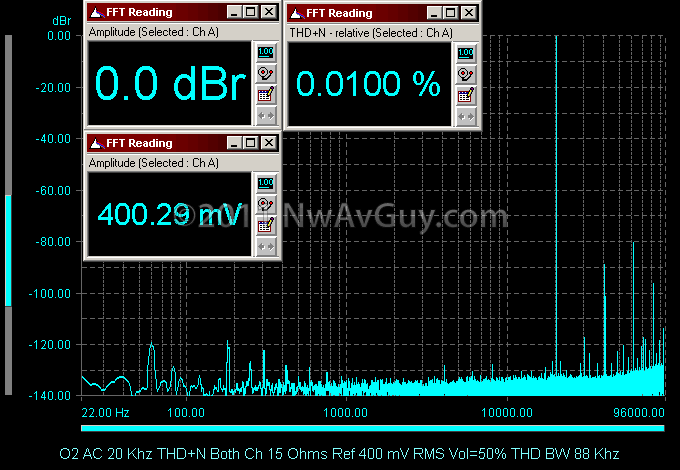


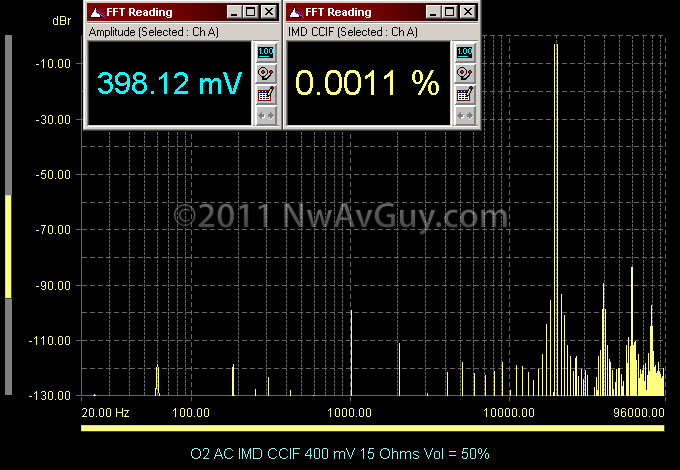
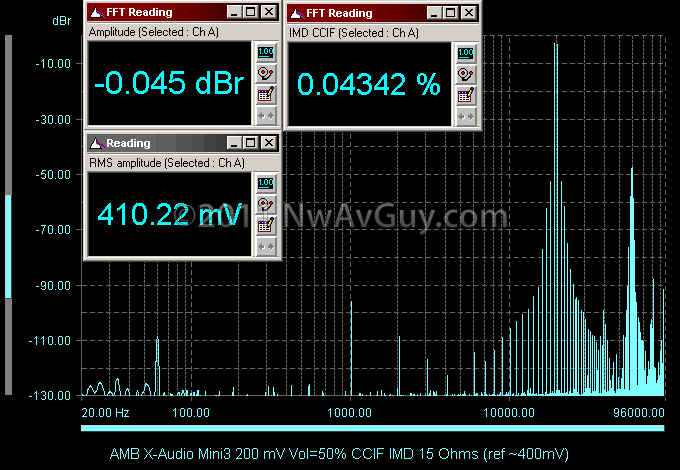
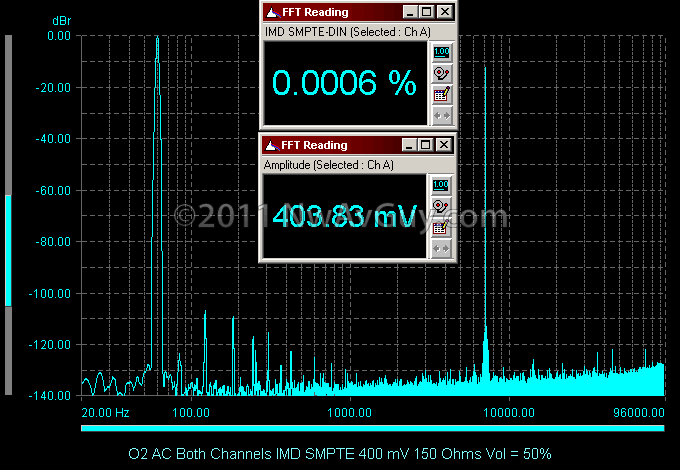


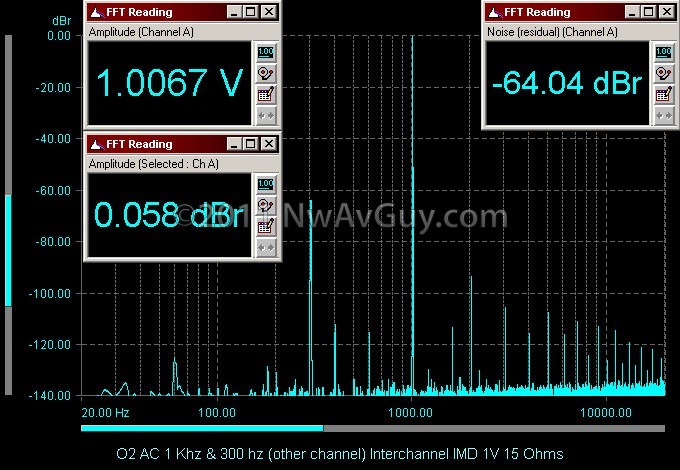
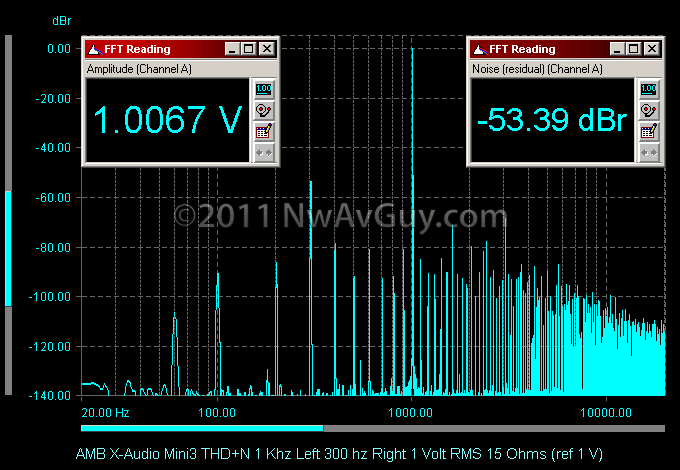
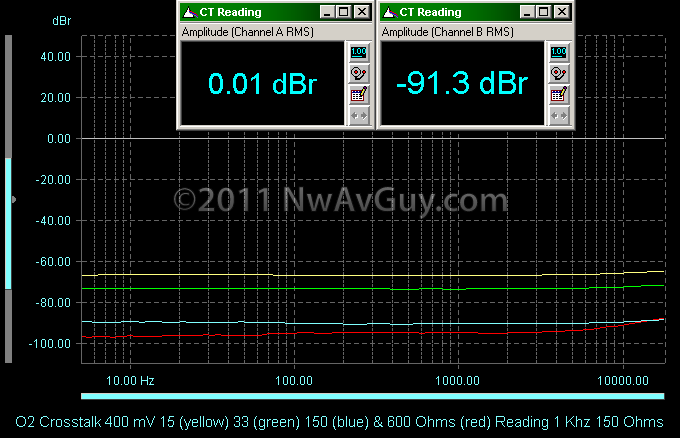
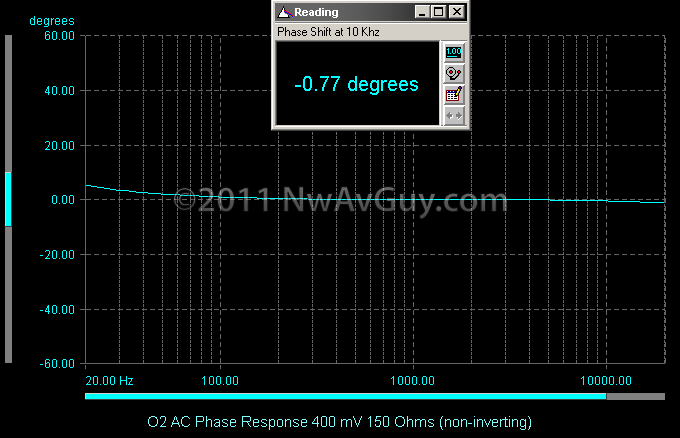
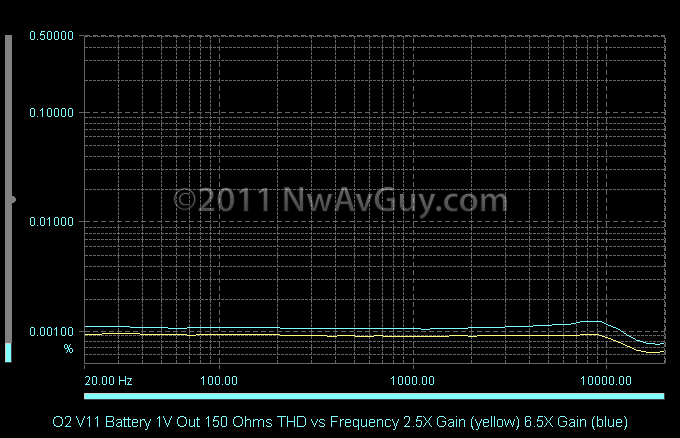
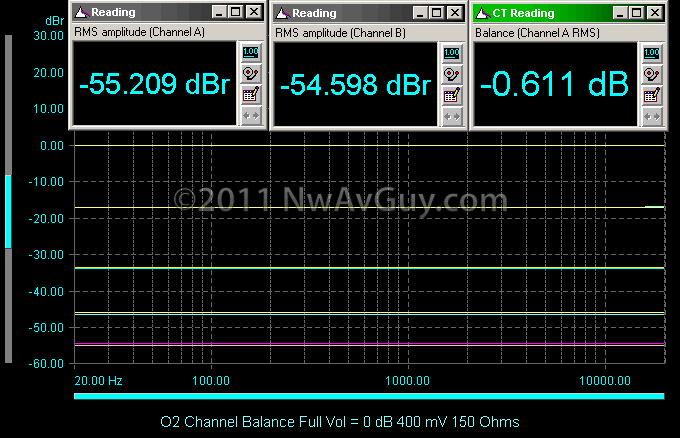
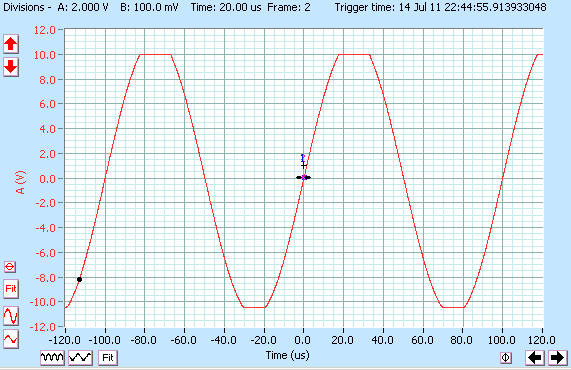


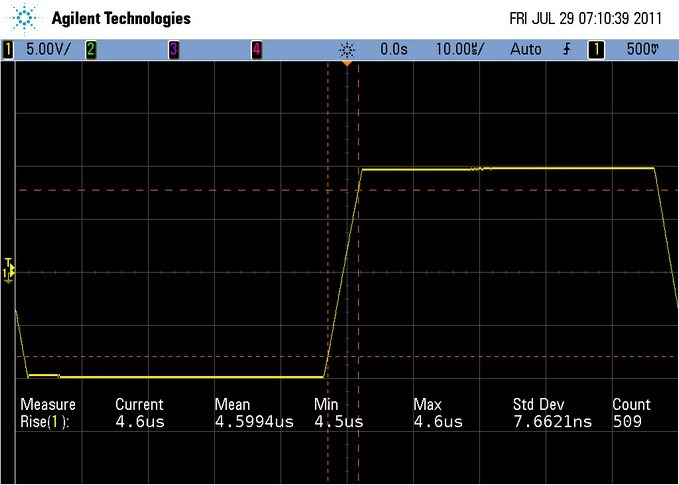
Whoa, that sounds (haha :P) reaaally cool. I can't wait for kits to be available!
ReplyDeleteOnly downside I see atm is that it seems to be quite a bit bigger than the FiiO E11 I use on the go now, but considering your measurements, it might very well be quite worth that.
Thanks for your work, and especially for making it available for free! (…and for this blog, of course!)
Johann
You're welcome Johann. I haven't tested the E11 yet. It's a virtual ground design, from what I understand, and it would be interesting to see how it compares to the similar Mini3. It would really depend on how well the E11 measures to know if the O2 was worth the size increase and extra cost.
ReplyDeleteI expect the O2 should do much better with high impedance power hungry cans than the E11 (I doubt the E11 can manage 20 volts peak-to-peak). So it also comes down to your headphones. But if you're happy with the E11 that's what matters most.
Wow. Awesome.
ReplyDeleteOne question.
Can a gain switch be implemented on this design or do you "set" it permanently by by picking the appropriate resistors when you build it?
Hey Maverick. Thanks. The gain is set with resistors. The PCB is fairly full and there's just not room for extras like a gain switch. The batteries take up a huge chunk of real estate, it's a multi-stage design, there are big caps, the power controller (low battery shutdown, etc.), full AC power supply, battery charging, and all the jacks and controls are on the board. And it's all through hole rather than much smaller surface mount.
ReplyDeleteGain switches might also degrade the performance as that's some of the most sensitive circuitry on the entire board and it can be rather sensitive to routing, noise, etc. But it can certainly be done with more available PCB space.
I guess I'll go with something in the middle for just home use from a normal strength source then. Not *quite* one size fits all but pretty close.
ReplyDeleteI can't wait for the follow up.
You mean choosing a gain in the middle? I'll think about the gain switch issue. Do you mean something externally accessible I assume? And do you mean the same headphones just difference sources? Or different headphones as well between portable and home?
ReplyDeleteI meant for use between portable and home with headphones of wildly different sensitivities (BA IEM vs planar magnetic) and different sources (~2V from an "average" line out on a DAC to whatever my Cowon D2+ can output).
ReplyDeleteNow that I actually think about it instead of just typing the first thing that came to mind I'm not sure if I'd really use it. I wouldn't want to displace my current portable amp because of its crossfeed. I usually get headaches without some form of it, but while I can easily add it via software at home on my PC, options for on the go use are more limited. I just got a little carried away.
An external gain switch would make the O2 very close to a "do it all" sort of amp for a lot of people though. Most people aren't as attached to DSPs and filter circuits as I am.
I *am* happy with the E11 with my 250Ohm DT770/2005, even at afaik ca. +/-3.5V peak-to-peak it drives them louder than my ears can handle with the iPod set to 3/4, yet a good amp that can be charged/powered while in use (a serious flaw of the e11! And also because of the virtual ground as far as I understood… :P) would be kind of a cool thing to have for longer listening sessions at work. ;)
ReplyDeleteOk, thanks. I agree gain switches are a good thing so I'll see if there's anything I can do. I've always been a fan of them on this blog. I can safely say you probably wouldn't be happy with fixed gain in the O2 with those extremes.
ReplyDeleteWow, that is a flaw if you can't use the E11 while charging it. That makes a really lousy desktop amp. If it's a single Li-Ion battery that would be 3.5 v (or so) total with the virtual ground at 1.75 which is only 1.2 volts RMS output. If it has two Li-Ion cells, or some sort of DC-DC covnerter, it could manage higher voltage. But if either of those is true, they didn't need to use a virtual ground.
ReplyDeleteThis is very exciting stuff indeed. I've been on the lookout for something that'll work well both with my sensitive BA IEMs aswell as a high impedance full-sized can, and as you say it's pretty hard to come by. Really looking forward to your follow-up article.
ReplyDeleteI'm dead sure, it sounds shrill, dry, too analytical, out of pace, congested and is downright unbearable with (insert your own sexy list of esoteric gear).
ReplyDeleteJokes aside, dude, you are literally my hero. I hope to own one of these amps as soon as possible.
I think I have seen a couple of designs with adjustable gain, which utilise jumpers. I guess the resistors for different gain settings are all on the board and the jumpers just route the signal differently. Probably a cost and space effective solution. Does it have a negative impact on sound quality? Not sure.
Excellent! Can't wait to see what it takes to assembly one. The only problem for me is to find a worthy USB DAC to pair with this...
ReplyDeleteFiio has some interesting new offers (D3, D5) in this area, but neither does exactly fit my minimalist taste (mic ins, seriously?)
Thanks, looking forward to the follow-up article!
ReplyDeleteI enjoy your posts (even if I don't understand all the technical details but you do a reasonable job of explaining to the non-techies); so are you going to have someone manufacture the 02 or is this going to be purely DIY? :)
ReplyDeleteWow, I'm impressed. I was planning to go with "the wire" over at DIYaudio but, price pending, this looks like a more promising amp as a whole considering the volume control, gain, case, front panel. The wire does seems to have better some better measurements in THD, but perhaps there is some difference in measurements. I'd be curious to hear your opinion on the wire's measurements. I would intend to use this as a desktop amp so it's unfortunate that you're using 1/8in jack rather than 1/4in. Is this purely to cater toward the portability or is there some other reasoning? Could the power supply noise be improved with a different power supply?
ReplyDeleteI can't wait to see more of the design details and pricing!
Interesting. If it's through-hole, that's something I could solder myself. Looking forward to new details! I've never tried those tiny surface mount components, and (after peering through a microscope to see them--just a slight exaggeration) I probably never plan to.
ReplyDeleteDon't quote me on this, but I think the E11 does DC-DC off of a single standard cell phone battery in the 3.5V range. Maybe I'm imagining it, but I thought I read that at one point. Otherwise it shouldn't hit anywhere near the claimed 35mW at 300 ohms (3.24 V rms or 9.16 V ptp). Apparently people drive 600 ohms Beyerdynamics and some of the more reasonably-sensitive planar magnetics off of it.
Thanks everyone so far for the positive comments and enthusiasm! Here are a few answers so far:
ReplyDeleteFOLLOW UP ARTICLE: I don't know the timing yet for the next article but hopefully by Wednesday next week.
ADJUSTABLE GAIN (Cer): I'm still looking into the possibility of an external gain switch. It's going to be a lot of work to try and find room on the PCB, however, and require going to 1/8 watt resistors (currently 1/4 watt). And mean a new PCB layout (by hand) to optimize routing, the ground system, etc. Right now you have to de-solder and replace 2 resistors to change the gain.
DAC PAIRING (Sami): It might be wishful thinking, but I'm going to be testing the Asus Xonar U3 which is a $40 USB thumb drive sized DAC. I'm fairly sure it won't have a great headphone amp in it at that size and price on USB power. But, if we're lucky, it will have a decent DAC in it (as Asus has done a good job with other Xonar products). If so, it would make a great pairing with the O2 for someone on a limited budget.
POWER SUPPLY NOISE (thegr8Brian) - If by power supply noise you mean the 60 hz bump in some of the plots it's always below about -110 dB and often around -120 dB and it's not coming from the O2's power supply (it's there even on battery power), that's just stray AC fields in my lab (which are rather higher than normal as it's full of PC's, equipment, etc.). It's present in most devices I test and you'll also see it in Stereophile tests, etc. It was worse in the Mini3. It's below the sum of the noise floor which is around -105 dB. That's literally not audible under any conditions. Try using Foobar or some player with volume calibrated in dB. You'll find even -55 dB is just about inaudible. Imagine turning the volume down another 55 dB from there and you'll have an idea of -110 dB.
THE WIRE(thegr8Brian) - The Wire is an interesting project and it's great to see someone provide real test results for a change. The bad news is it's surface mount and significantly more expensive than the O2. The O2 is also more self contained, has onboard battery power, charging, etc. Performance wise, I can't imagine any real world situation where you'll be able to tell them apart. Both amps are well past the point of diminishing returns for accuracy. But if you're after the absolute best specs, The Wire will beat the O2 (just like the DAC1 does) only at high frequencies into low impedance loads. Everywhere else the differences are likely insignificant and/or due to the test conditions.
E11 - Thanks for the follow up on the E11. If FiiO already put in a DC-DC converter, it would have been relatively trivial to make it a bipolar output (i.e. +5 and -5 volts) with a real ground. I need to test an E11 and find out how well the virtual ground works. Regardless, it sounds like the O2 still has at least double the output voltage of the E11. I'm betting it also has lower distortion, much better crosstalk, and you can use it all day long as a desktop amp (the battery will apparently die on the E11 as it can't charge and play at the same time).
DESIGN EXERCISE - I should point out I didn't really design the O2 to be the ideal commercial product to meet as many needs as possible. It was mainly a design exercise to show you don't need the latest fashionable parts, exotic circuit designs, etc. to get great performance. The idea was a minimalist amp with the best objective performance possible for the price.
ReplyDeleteMANUFACTURING (Anon) - As for someone manufacturing the O2, I'm set on keeping this blog non-commercial. So I'm not going to be selling anything or even partnering with anyone where I get a portion of the profits (like at AMB). But if someone wants to offer the O2 as a completed amp, they're free to do so.
My hope is once some O2s are out in the wild, and hopefully people like them, one or more businesses that are already set up to make and sell similar products will add it to their product line.
Perhaps the most likely near term scenario is a finished PCB for sale that can be bundled with the AC adapter, Box Enclosure case, and a front panel from Front Panel Express. The customer would just have to slip the board in, install the batteries, and screw the front and back panels on. No soldering iron required.
1/4" JACKS (thegr8Brian) - There simply isn't room in the O2 for a 1/4" jack. They're relatively huge in terms of PCB space. So it would have meant making the entire amp much bigger and much less portable. The cost would also go up substantially as PCB's are priced per square inch and the case and front panel go up considerably as well.
The good news is anyone is free to buy the next larger case (like the taller B3-080), adapt the front panel CAD file I'll be supplying in FPE's free software, and you can panel mount one or more 1/4" jacks below the PCB (which will still slip into the B3-080 slots) and just solder short wires to the PCB. Then you'll have both 3.5mm and 1/4" but it requires a bit more DIY effort. I suppose I could offer both panels to make that a bit easier and provide a part number for a Neutrik jack. I'll look into that!
How can something so small power everything under the sun! :P Awesome.
ReplyDeleteCan this not run without batteries in it? what is the aprox. total cost? I might be interested in trying to make it one day if it's not too expensive and if I didn't have to replace the batteries every once in a while (I'm only really interested in a desktop amp). I also concur that an easily adjustable gain would be great as long as it doesn't hinder the performance.
-Satellite :o
COST (Satellite) - I'm not revealing the price just yet for a few reasons one of which is I don't know the PCB cost yet (which depends on how big the first run is). For now let's just say I'm used to cost optimizing my designs and think I did a pretty good job here all things considered.
ReplyDeleteBATTERIES (Satellite) - It works perfectly without any batteries. You could also use disposable 9 volt alkaline batteries if you wanted (just don't try to charge them). It's also reverse polarity protected.
Awesome. I would also suggest sticking to the basics and keeping the design minimalistic and solid.
ReplyDeleteIf someone really needs two totally different gain settings then why not just build two of them (desktop with high gain and portable with low gain I guess). But I think a reasonable gain value (depending on your source) should work very well with a variety of different headphones and the volume control balance is fine so use it. Generation Y seems to have forgotten how to use it but I have to admit it's also the industry's fault for compressing sound to crap.
GAIN (anon) - I agree and think most DIYers could build it with a suitable gain (even if it's a carefully chosen compromise) for their source(s) and headphone(s). However, there's already substantial interest from many (some have messaged me privately) wanting to buy a completed board or amp. And this has only been posted for mere hours so I it might be just the tip of the iceberg.
ReplyDeleteFor those without a soldering iron, a gain switch could be seriously useful. So if I can pull it off without too much extra work and without compromising the performance, it would be worth it.
(me from 11:14 AM again)
ReplyDeleteSure that sounds fine. But if you, for example, make the voltage gain switchable between 2 and 5 then you could also just build/sell completed boards with either fixed configuration which the buyer can choose from.
In other words, I don't think the main request is to have a gain switch, but to have a choice between high/low gain builds. Just a guess though.
Looks promising so far. Great job! Do you think that implementing Li-Ion batteries with an appropriate charging unit (CCCV shut-off, etc) would be possible with this? Also, do you think the larger case would allow integrating a DAC alongside this without compromising the measurements significantly(for those of us who are more ambitious)?
ReplyDeleteThe link is fixed to:
ReplyDeleteTheir Brain Will Likely Deceive Them
Li-Ion (SpaceTimeMorph) - You could use Li-Ion power. The best solution would be a single cell and a bipolar +/- 9 (or 12) volt DC-DC converter. And you'd have to make sure the EMI from the converter didn't make a mess of the amp's noise floor or distortion. If someone was going to turn it into a commercial all surface mount much smaller product that would absolutely be the way to go. But for DIY use, the 9 volt batteries work very well even if they're a bit more bulky.
The low battery shutdown solves the biggest problem with 9V NiMH batteries--cell reversal. If you never discharge them too low, they last a long time in terms of both years and charge cycles. And it's a more "pure" power supply than all the EMI/RFI hash you get from any DC-DC converter. You can't beat a battery for low noise.
INTEGRATED DAC - I think that could work. I'd probably use a commercial DAC (even if it's just the PCB) rather than a DIY DAC (most of which I think are rather half baked and not sufficiently well tested--RMAA just doesn't cut it). Having the DAC on a different board should keep the noise issues at bay.
ReplyDelete"The O2’s gain is adjustable, and if your headphones sound better with a higher output impedance, that’s easily accommodated too"
ReplyDeleteSince the gain switch discussion already took place I just wanted to add to "output impedance" discussion.
Close to zero ohm output impedance is certainly the goal. It makes perfect sense for reasons you state above.
As you wrote yourself many amps do not have an output impedance close to zero ohm.
The one thing I am concerned about is that many manufacturers of headphones know that. I can thing of some cases where the manufacterer even took the output impedance of the typical source, where the headphone will be used, into the account, while designing the special sound of the headphone.
From "and if your headphones sound better with a higher output impedance, that’s easily accommodated too" I can deduce that you know that a higher output impedance can result in a better overall performance in some cases.
So the question basically is: How to you want to achieve a higer output impendace?
Put in some resistors at a certain place in the final design would set the amp to fixed configuration with an higer output impedance. So your amp would be a solution for close to every headphone but not for people who want to drive several different ones at the same amp.
So basically can you include the possibilty to alter the output impedance of the final amp without using a soldering iron.
A possibility to adjust it with a screwdriver or simply by hand would be nice.
I know this would not be necessary for most people, due to the fact that on the one hand the most don't know about the influence of the output impedance and on the other hand not everyone wants to use diffent low-impendance in-ear monitors with multiple balanced amature drivers and/or several other headphones.
Since your design aimes to satisfy close to everyone needs as far as it is about the tech specs and not about "high-end status" or "fancy housings" I assume stating the problem and let you know is legitimate.
One last thing. Nice work. I really like your blog and appreciate your effort.
OUTPUT IMPEDANCE - Right now you can set the output impedance with resistors on the board. I'm not going to provide a switch, jumpers, etc. A pot wouldn't be practical for performance reasons.
ReplyDeleteThe best solution is to use the 1/4" jack method discussed in the comments above. If you use the B3-080 case you can add extra jacks and wire resistors in series with some or all of them. So you could have "zero ohm", "10 ohm", "120 ohm", jacks and just plug your headphones into whichever was the best match.
Good for you AVguy!
ReplyDeleteNow, how about a desktop amp that measures with the best of them?
And even better, how about a desktop amp with a built in DAC that measures right up there with the Benchmark?
We know you can do it.
Well, we can wish, can't we?
ReplyDeleteWhat about a desktop then?
This is great news. I was going to ask if you might consider designing a headphone amp. I can't wait to hear it. Sign me up!
ReplyDeleteDESKTOP AMP: I compare the O2 to the QRV09 and E9, both of which are desktop amps, and the O2 mostly beats them. And the 2 areas it doesn't are:
ReplyDeletePower below 33 ohms - This is actually a good thing as I'm not aware of any headphones that need 1 watt at 16 ohms. But there are lots of headphones that can be damaged by that much power. Again, the O2 can drive any headphones I know of.
HF distortion below 33 ohms could be improved at higher output levels. But I don't think this is even close to being an audible problem. Most of the distortion components are out of band (ultrasonic) and the CCIF IMD test with 19 Khz and 20 Khz shows the O2 aced the 1 Khz in-band difference signal (which the desktop amps did much worse on).
The ear's sensitivity for audible THD is a "U" shaped curve that's most sensitive around 500 hz - 1 Khz and dramatically rises at both ends of the spectrum. There's an AES paper on the subject. THD of 0.02%, or even 0.05%, at higher frequencies is nothing to worry about.
So yeah, I could design a desktop-only amp with higher power and more expensive parts that would have lower HF distortion. But would it sound any better? I don't think so. I try to be practical rather than taking an overkill solution where there's little or nothing to be gained. If you want a desktop amp with lower HF distortion, build The Wire with the LME49600's.
If you want a practical desktop amp, that so far nobody can tell from the DAC1's, build the O2 and leave the batteries out. Done.
"So if you want a desktop amp, build the O2 and leave the batteries out. Done."
ReplyDeleteYou clearly don't understand the audiophile desktop headphone amp market. You need to build the O2, put it inside a much larger case, weigh it down with a brick, (and importantly) give it a fancier name, and then you're done. Bigger size means better audio quality of course. ;)
Actually, the B3-080 mentioned earlier is a bigger case with room for fancy 1/4 jacks, a blue LED, and a nice lead weight inside! But I think some sort of heavy unobtanium cosmic radiation shield would be more appropriate so the marketing guys had more to work with.
ReplyDeleteI've revised the article to provide more info on desktop options with the O2. You could also use chassis mounted RCA jacks on the back with the B3-080 case.
Very impressive! I develop web pages and know all the hours it would take just to write such a huge article let alone design the amp, build it, test it, refine it, test it some more, etc. Nice work!
ReplyDeleteDo they know about this over on the AMB forums yet? You may not be everyone's best friend there, but from what I can see, many there would be crazy to ignore this. And you're absolutely correct about a lot of DIY stuff not being tested properly (or tested at all).
It's also refreshing you're not raving about the sound of Vishay resistors over Caddock or other such nonsense like the "sound" of different brands of power supply caps. But then again, you're a fan of Doug Self et al. so I'm not suprised.
I'm looking forward to the next article and I'll build one if the cost is reasonable and there's a PCB available. And thanks for rest of the blog too. Most guys write a lot less in a month than you do in a single article. You might, however, want to think breaking it down into more accessible chunks.
Don't forget to include a few layers of this stuff if you do decide to build it to true audiophile standards:
ReplyDeletehttp://www.head-fi.org/forum/thread/300753/stillpoints-ers-cloth-works
Seriously though, I just had a thought that you could have a little competition here before releasing the technical details. Based on the information you've provided about the general design principles and the performance data, let people try to guess what the circuit looks like.....
Thanks for the encouragement Trent. I have no idea about AMB. I've been banned/blocked there and haven't bothered since. I agree many there should be interested, but much like going against a sponsor at Head-Fi, any positive posts about the O2 at AMB might have an uphill battle. And that's too bad because AMB could offer this design alongside the rest of what's there, Ti could make some money off it, and it would be a win-win for everyone. Mister-X could even build them for people.
ReplyDeleteInteresting idea FakeMilkshake. Anyone is welcome to pose such a challenge including starting a thread say at diyAudio if they want. I expected the most speculation to be about the price but so far only a few seem concerned about it.
Price is a problem when you don't get what you paid for. Whether this comes out at $50, $100 or $150 is not really a dealbreaker for me because I understand and agree with your design philosophy. Having said that I do hope it's not much more expensive than that!
ReplyDeleteWhat are the timescales you have in mind for releasing the design and possibly offering the populated PCBs you spoke of earlier (or bare PCBs for that matter) ?
I should have the design article up by Wednesday (Wednesdays are when I try for a new article each week--things got a bit off adding the Head-Fi Ban article as a timely response to the ban).
ReplyDeleteA populated PCB is more tricky. Understandably the places I've talked to so far are not willing to take the risk of building a bunch of populated boards if they don't know if they can sell them. So they want someone else (me) to pay for the first production run. And I'm trying to stay out of this from a commercial perspective.
I'm hoping this can start small with a bare PCB, hopefully get some interest built up, and then someone might want to take on a small production run of boards. It might be possible to do a "pre-order" situation where people place orders for boards that don't exist yet and their credit cards will not be charged until the boards are built and shipped.
But, for now, I want to get the design finalized, get some amps built and into the hands of those who can comment on them (there's even someone in the Banned at Head-Fi comments who has access to an Audio Precision who's offered to test one), and see how things go from there.
Great job, NwAvGuy!
ReplyDeleteI'm really looking forward to your next article - especially as you know all to well how to keep your readers curious. ;)
Nah, kidding beside: Take a short rest, you've been busy these days. We're already hooked on the O2, so no worries about us losing interest, y'know?
Almost can't wait for the estimated price, though...
Also, thanks very much for your blog. I enjoy reading it!
Oh, I nearly forgot:
ReplyDeleteWhy not deal with this whole PCB-situation over a platform like Kickstarter (http://www.kickstarter.com/)?
Chris, thanks for the kind words. As for Kickstarter I was aware of it but hadn't considered something like that for the O2. It's an interesting possibility. I'll do some more research, but my initial reaction is I'd be happy to give my approval if someone else wants to create a funding project there for the O2? I'm really trying to be just the designer here.
ReplyDeleteThe cost for bare boards is fairly minimal. The cost for completed boards would be quite a bit higher--especially if they're made in the USA. Obviously I need to get the Bill Of Materials finalized first (i.e. will there be a gain switch, etc.).
Hi NwAvGuy, the two last post were amazing. I really have nothing to add, I realized long ago about the frauds in the audiophile scene and the head-fi scam. Thanks to this blog now I'm really sure.
ReplyDeleteCongratulations and keep the good work going! This blog is surely a gem for audio enthusiasts, incredible what you achieved in such a short time.
Just one humble advice, as well as it is clear that Head-Fi and such have no hope, some (IMVHO) honest DIYers like amb may be worth collaborating with in a more friendlier tone. The may perform mistakes, but I'm sure not intentionally.
Thanks Anon. I'm sure, like at Head-Fi, there are plenty of good guys hanging out at AMB. And I agree I could use a more friendly tone at times.
ReplyDeleteBut, with AMB, I was tried and hung up for dead there before I ever even made my first post on their forum. So I was off on the wrong foot from the start. I even initially said rather good things about AMB in my original review (before I was banned). But, the overwhelming reaction there was a lot like with the Schiit Asgard and Nuforce uDAC at Head-Fi. The loyalists couldn't accept their gear wasn't what it was made out to be. Hence they were saying really ugly things about me before I even got there. If you haven't read it, I try to explain it more in my Subjective vs Objective article.
As for mistakes, I've shown with measurements and math/theory how several of Ti Kan's claims are literally impossible. If they're just honest mistakes, why doesn't he simply correct them?
In my opinion, it's a less extreme version of what's going on at Head-Fi. Ti has built up a reputation for his designs, which have lots of loyal followers, and when someone comes along with contrary information, it doesn't go over very well. As someone said in the Head-Fi comments, it's like pulling the beard off Santa in front of the kids revealing it's really your drunk neighbor. It would seem Ti is trying hard to keep Santa's beard on.
Dear NwAvGuy, thanks again for your comments.
ReplyDelete"If they're just honest mistakes, why doesn't he simply correct them?" I guess they overreacted to what badly understood "hostility". AFAIS amb doesn't have access to high-end testing equipment so he cannot really verify your results. Last I heard he was searching for a professional audio analyzer.
I'm really eager to see that O2 design, I'm sure I will build one. Maybe batteries could be improved (in the style of amb's Xi 1) or by fully replacing batteries with a high-end bipolar power supply, thus making a killer desktop amp.
Regards!
"or by fully replacing batteries with a high-end bipolar power supply, thus making a killer desktop amp."
ReplyDeleteI'm going to build the O2 but I really want the improved desktop version.....
This thing is called the Objective2 so, at the risk of sounding like a total geek, I'd like to try and keep things factual and address the power supply issue...
ReplyDeleteYou can put a scope on the power supply in the O2, AC couple the scope so you can crank up the sensitivity to see whatever signal/noise/etc. is on the power supply rails, drive the poor O2 to worst case conditions into a difficult load with music, sine waves, square waves, or pink noise, and there's just not much to see.
At most, I've only seen a 0.1 v p-p worth of signal/noise/ripple/etc. on the supply rails. That's 35 mV RMS. Then you apply 80 dB of CMRR (it might be closer to 90 dB) and you get the equivalent of about 3.5 uV in the audio signal.
That's about -110 dB referenced to 1 volt which is far below the generally accepted -80 dB threshold of audibility and well below other distortion products when you're driving the amp that hard. Under more normal operating conditions (i.e. currents you would use with real headphones and music) it's more like -120 dB.
So that's a long (engineering) way of saying the AC power supply in the O2 is not a limiting factor in any objective way. Trying to improve it would be a waste of money.
For what it's worth, I've done audio differencing tests in the past where you literally subtract the output of a piece of gear from the input. What's left over is the distortion, noise, hum, frequency response errors, phase shift, etc. It's pretty much everything the amp is doing wrong and the test can be done with real music driving a real load. I've played around with different power supplies and the difference result didn't change.
One could also build two O2s and compare them blind. To keep it simple, you could have one on battery power and they other on AC and (staying within the battery's voltage swing) I'm quite certain you won't hear any difference. You could do the same with a beefed up power supply in one. Again, you won't be able to tell them apart.
No. Keep it simple, and keep it as cheap as possible - I loved the idea from the get go and I'm a bit sad to see the point fly over some people's heads.
ReplyDeleteI'll second that, b0ck3n.
ReplyDeleteBesides, @NwAvGuy:
Just a hint, with kickstarter, nothing more. I can see why you don't want to manage this matter too. Your challenge wasn't to distribute a wire with gain - just to build one on a budget.
Thanks for the added feedback b0ck3n and Chris.
ReplyDeleteAnon: The measurements were made using what I had hoped would be the final PCB. You can see the board in the pictures (the picture at the start of article can be opened for a larger version).
But I've come up with a few minor revisions, and now there's the issue of the gain switch. And that's not minor as there's just not space for it on the current layout. I was hoping the final PCB was going to be very similar to the one I tested but that's no longer true if a gain switch is added.
PCB layout can have a substantial impact on performance. But that's mostly about knowing what you're doing when you locate components and route the board. So even if the board substantially changes, it will be laid out and routed with the same priorities and should deliver very similar performance. I will verify the measurements on the final board and revise anything that significantly changes.
Maybe we should review why we need a gain switch.
ReplyDeleteThe more I think about it, the more I like the original concept.
You didn't think it was necessary in your original design.
As a DIY amp I think the majority could be happy without a gain switch. That's because DIYers are free to optimize the gain to best suit their needs when they build the amp.
ReplyDeleteBut a lot of people (many privately) have expressed an interest in wanting to buy at least a finished board, or even complete amplifier. And for anyone without a soldering iron, a gain switch can be very useful to match the amp to their needs.
Even if I add the switch it can be optional during construction (like a few others things are on the O2). So if you only need a fixed gain, the amp can easily be built that way. And I can provide FPE files for the front panel with and without the opening for the switch.
And some, with multiple headphone and/or source requirements, might still make good use of a gain switch in day-to-day use. For DIYers they can have two optimized gain settings--say one for home and one for portable use with a different source and headphones.
Would the standard gain allow the the amp to be loud enough even for hard to drive headphones like 600 ohm Beyers? If so, pardon my ignorance and forget the gain switch if it's a lot of work, seriously.
ReplyDeleteOne more thing, is there any advantage to a 1/4" inch jack (sound wise) or is it irrelevant?
-Satellite :)
It depends on your source output and your headphones. Most portables can only manage about 0.5 volts out. Home gear/DACs typically output up to 2 volts--4 times greater. And B.A. IEMs need very little drive, but 600 ohm cans need a lot.
ReplyDeleteIf you set the amp up to drive say the 600 ohm version of the DT880's from an iPod it would need around 6X or 8X gain (16 - 18 dB) to really play loud. But plug in Shures, Ultimate Ears, etc. and you wouldn't get the volume past 9 O' clock. The Benchmark DAC1 handles this problem with internal gain jumpers.
As for 1/4" jacks, as mentioned earlier, they can be added if you want more of a desktop amp and use the next taller case. Then you can panel mount a 1/4" jack (or two) and still have the 3.5mm (1/8") jacks as well. I'll provide an alternate front panel FPE file that makes that fairly painless.
Do I think they 1/4" jacks have benefits? It's subtle, but overall there are a few benefits assuming you own headphones with a "native" 1/4" plug. The contact resistance is lower which reduces crosstalk, and 1/4" plugs are less prone to add noise to the signal when you move the cord around. They're also more durable.
Hmmm, maybe a gain switch would be best then for a "do it all" amp. I'm sure you know best either way tho.
ReplyDeleteThe tiny little box sitting next to your HD 650's does look appealing, but I think ideally I would ruin it's small size to stick a DAC and 1/4" jacks in it. Also make it green :P
I look forward to more details, keep it up! I would definitely be willing to make one, given enough time.
-Satellite
Hate to bother you, but are you posting on any forums atm?
ReplyDeleteIt's really hard to have conversations here....
I'm not posting the O2 on any forums yet. But as soon as I get the next article online with the design details I'll start a thread on diyAudio and ABI. In the meantime, everyone can either post here or send me a private message. Thanks.
ReplyDeleteKudos. I will build one when possible.
ReplyDeleteI would love to see a "normal" desktop amp version of this design (without batteries)
ReplyDelete+1 for a gain switch (I'd like to use my grados AND the Hifimans with it)
Also,I'd love to see the AD843 or the OPA627 in the design :)
Good luck! I'll be sure to try it out as soon as its available...or even build it myself if it will be easy enough :)
I think you've got the O2's crosstalk wrong on your measurement summary. It says corsstalk at 15 ohms, but you listed the O2's corsstalk at 600 ohms (according to what the graph further down says anyway) instead.
ReplyDeleteIt sounds like you are warming up to the gain switch yourself, NwAvGuy, otherwise I was about to suggest that any refinements should be saved for a later 'deluxe' version and the layout frozen at or near its current form. Listen to the suggestions, by all means, but it's not really feedback because nobody has actually played with the O2 yet. I for one am excited about the amp exactly as described and I don't want it to become a massive drain on your time. It sounds like the gain switch would push the design past its current form and necessitate major reworking of the layout. If that's something you want to do, awesome, but it sounded to me like it was pretty much ready to roll.
ReplyDeletePS. I keep my 3.5mm plugs clean - generally give 'em a wipe on my T-shirt before plugging anything in - and I never have crackling issues so I don't care about the 1/4" jacks either. I haven't had great experiences though when building gear with the plastic box (one transparent side) type of jacks as used in the CMoy you reviewed.
ReplyDeleteCROSSTALK (Maverick): Thanks for catching the crosstalk mistake. It was the 150 ohm number. I should really list the crosstalk in the table at both 15 and 600 ohms. As the first is indicative of the the ground system, power supply issues, EMI induced crosstalk (inductive coupling), etc. While 600 ohms is more indicative of capacitive coupling, the volume control, etc. But a lot portable devices are intended for low impedances so that's why I chose 15 as the across-the-board standard. So you can fairly compare say an iPod to an amp.
ReplyDelete3.5mm JACKS:(fakemilk): The jacks in the O2 are not high-end but they're the best I've found at Mouser (single vendor shopping) and rated for 5000 cycles. Higher-end PC mount through hole jacks are hard to find these days. All those fancy gold ones you see on commercial gear are usually surface or panel mount. And no, I didn't use the ones with the clear windows.
AD843 & OPA627 OP AMPS (anon): I know the article is really long, but there are a few places where I talk about "designer" op amps and how the O2 is far more accurate and performs better than the AD8397 in the Mini3. I'm trying to show with the O2 that implementation is at least as important as the parts. The noise performance of the O2 is the most obvious example.
I tried nearly 2 dozens op amps in developing the O2 and have already started a future article to cover the differences and talk about "op amp rolling". I think many might be surprised at the results!
That's fantastic news! It`s about time for us to have a good amp at a reasonable cost!
ReplyDeleteI just have one simple question:
I'm using a Behringer UCA202 with my active speakers, and I would like to use an O2 with it for my HD555s. Do I need to connect it to the line-out of the UCA202, or can I connect it to it's headphone output? It'd be a bit annoying having to swap between the speakers and the O2 all the time.
HEADPHONE vs LINE OUT (Vittau) - Thanks! You will probably get slightly better sound from the line outs. I would try a couple of cheap RCA "Y" splitters and then you can leave both connected at the same time. You might need to leave your speakers on and just turn down the volume, however. Some inputs create excessive load when the device is turned off.
ReplyDelete"Some inputs create excessive load when the device is turned off. "
ReplyDeleteI usually split the outputs of my dacs between 2 amps, with only one amp on at a time. Is excessive load something I should be concerned about?
Thanks
GOOD NEWS! GAIN SWITCH IMPLEMENTED - I managed to squeeze in the gain switch and extra gain resistors. That required re-routing the entire board as I had to switch to smaller 1/8 watt resistors for most of the 24 resistors in the design. I also had to re-arrange the front panel jacks and controls to make room for the switch and generally shove everything around some.
ReplyDeleteAs is often the case with PCB work, this iteration benefits from things I wasn't crazy about with the last design but couldn't justify the many hours needed to fix. So, despite the extra gain circuitry, the new layout may perform better overall--especially into lower impedances--as it incorporates some other improvements.
EXCESSIVE LOAD (anon) An amp creates excessive load depending on how the input stage (circuit) is implemented. Many amps have a fairly low series resistance to the op amp or first input transistor in a discrete design. When the amp is powered up the input will be at the design impedance (say 47K). But when it's powered down, it looks more like a diode connected to the un-powered supply rails which are effectively ground. So up to about 0.35 V RMS you're fine but above that the "diode" starts to conduct and provides a low impedance path to ground. This "clips" the audio input signal by effectively shorting it to ground above a certain voltage.
How much that effects the source (your DAC) depends on how low of an impedance your source can drive without excessive distortion, and how much series resistance (which is different than the much higher input impedance) in in the amp's input. Often there's only around 1K or even less. There's also often a capacitor, but that doesn't help as it looks like a short at audio frequencies.
You can configure an input circuit so it won't load the source when the device is off, but such an input typically has significantly higher noise. So it's not done very often--especially on a power amp designed to run at "wide open gain" all the time. So beware.
Would this O2 amp be ideal to add inbetween my asus xonar essence st and hd 650? Or is the ST headphone amp fine enough alone?
ReplyDeleteWhen i tried M-Stage with ST and HD650 sound got muffled, and when i tried M-Stage with HRT MS2 instead of ST the sound was muffled as well. Will the O2 be a good match for soundcards?
Also would something like ipod -> o2 -> hd650 be the ideal?
SOUNDCARDS (Poelaert) - The Xonar ST soundcard received a decent review at Stereophile so, in theory, it should be OK without an amp with your headphones. I can't explain the "muffled" sound with the M-Stage unless there was something wrong with it, it's just a lousy amp, or you're using two different outputs one with some DSP applied (via the Asus driver/software) and the other not? That's one thing I don't like about audio device that needs a proprietary driver--a lot of them have extra processing features (DSP) that alter the sound and you might not even be aware are enabled.
ReplyDeleteI know the HRT MS2 is a fairly solid product and not "muffled". And the interface between a line output and an amp input is normally relatively transparent. So it might be that's what the music is supposed to sound like and you're used to an altered version from the Xonar?
Im certain that i had DSP effects off in the driver.
ReplyDeleteI have only tried the HRT with the M-Stage, so it is most likely the M-Stage which is to blame then.
Seems like the HRT and O2 will be my future portable setup while my ST will make my HD 650 happy.
Good luck with the project!
Thanks, in case you missed it, I also plan to test the Asus Xonar U3 which is much more portable (and cheaper) than something like the HRT DAC. If the DAC in the U3 is decent, it would make an excellent portable companion to the O2.
ReplyDeleteAnd props on the HD650s. I really like mine but they're something on an acquired taste for some.
My Setup is MS2 -> M-Stage -> HD 650.
ReplyDeleteThe M-Stage is a dark amp and I think it's more dark than the MS2 is bright, so that's probably why you are getting "muffled" sound. (I guess it fails objectively, but I love it).
Yay for improvements. :)
-Satellite
One question about the 1/8 W rated resistors. I guess it's negligible but that change adds a bit of noise, doesn't it?
ReplyDelete"The ear's sensitivity for audible THD is a "U" shaped curve that's most sensitive around 500 hz - 1 Khz and dramatically rises at both ends of the spectrum."
ReplyDeleteWell, obviously, your lack of ability and knowledge has been exposed here, and your cloak of anonymity cannot protect you. And you have an ugly car. Oh, wait, this is not Head-Fi... :-)
But seriously, I think you meant "The ear's insensitivity...", otherwise the statement contradicts itself.
As far as those wanting the big-bux feeling and looking desktop model, how about letting them use an expensive looking box and stuff your completed unit inside. You know, like some of the esoteric makers did using Oppo products stuffed wholesale into their fancy chassis. Heck, they could even just buy an expensive phone amp, strip out the guts and replace it with yours. Then they can brag they actually did overspend, and they have great sound. Just a thought...
1/8W RESISTORS (anon) - (just revised) Good question! With SMT resistors they get significantly more noisy as they get smaller. With through-hole resistors, however, the data I have shows below 68K, the noise rating is the same. And every single resistor in the audio path in the O2 is well below 68K. Here's a link to the datasheet of some of the Vishay resistors I've specified that compares the 1/8 watt size (SFR16S rated at 0.5 W) with the larger versions:
ReplyDeletehttp://www.vishay.com/docs/28722/sfr16s25.pdf
The O2's noise floor is (barely) above the dScope's so if the broadband noise goes up it will measure it. If that happens it might be fun to experiment between the sizes. But I suspect it's not going to significantly change. And it would have to go up quite a bit to be audible.
Interestingly, through-hole resistors may have a bit more inductance, but they tend to be more linear and follow Ohm's law better. SMT resistors (especially 0805 and below) have a significant voltage coefficient--basically the resistance changes depending on the voltage applied. And in audio, that's not good.
Some believe SMT resistors sound better, perhaps because they're less inductive, but the thick film SMT resistors are fairly awful and significantly non-linear. While thin film SMT versions are much better but they're still not as good as through hole in the data I've seen.
Thanks for the gain switch. That can really come in handy when your 2 favorite pairs of headphones have more than a 20dB difference in efficiency between them.
ReplyDeleteAny idea about the total cost? (If this is going to be covered in the next article, ignore this.) Really interesting project.
ReplyDeleteHi NwAvGuy, thanks for taking time to design this amp. I have a very noobish question for you; is it possible to use this as a preamp for my active speakers? sry for my ignorance :P
ReplyDeleteI think I cried. Maybe my quest for the perfect amp ends here?
ReplyDeleteI am going to build this bad boy, it doesn't matter if it is my FIRST DIY project. If it meets my expectation, I will sell my M3 and Mini3 and tatoo your photo on my arm.
Oh and I remember all the fools on HeadFi/AMB forums saying " meh this guy probably cannot even design a proper amp "
KIND WORDS (Darknight670, Maverick, etc.) - Thanks for all the encouragement! The O2 isn't perfect but I believe it's more than close enough for most applications if you prefer your music without added contributions and alterations from your amp.
ReplyDeleteBIG BOXES (heycarnut) - See "A Note To Bling Lovers"--I covered that already. And thanks for the minor semantic correction.
COST (rrp) - All shall be revealed soon enough ;) Let's just say the O2 is designed to beat the competition in as many areas as possible.
PREAMP (anon) - Why not run your source directly into your active speakers? If they don't get loud enough the O2 could help but there are probably better solutions. Headphone amps (especially this one) are designed to drive much more difficult loads to higher voltages than is required of a pre-amp so it's overkill.
I'm also interested in using the O2 as a pre-amp to my Class A or Class AB amplifier. You mention that it may be overkill, but I've already built the O2 and use it as a headphone amp; it would be more expensive to build a separate pre-amp.
DeleteThe "DAC1 PRE" serves as a pre-amp/headphone amp. Could the O2 serve the same dual function? What output voltage can I get from the O2?
Hello,
ReplyDeleteLooking forward to the PCB/kit. What do you think about driving a headphone with balanced output (and the necessary rewiring)?
hifiduino
4 WIRE CONNECTIONS (hifiduino) - The O2 PCB already has a 4 wire "header" for off-board headphone jacks including a "balanced" 4-wire jack. If you mean fully balanced outputs where neither side of the headphone driver is connected to ground, that would likely yield worse performance as you replace an essentially perfect "straight wire" (a real ground) with an (imperfect) amplifier. See Virtual Grounds for more info.
ReplyDeleteColor me impressed! A buddy sent me a link to this design as I'm looking for a headphone amp and open to DIY. I previously was thinking of one of the AMB designs (M^3 or Mini3) but clearly the O2 is in a different league and I now have my doubts about the whole AMB thing.
ReplyDeleteI don't think I've ever seen anyone as thorough with a DIY design. And it's even more surprising you've done all this work for zero cash in return. KUDOS! Philanthropy reaps its own rewards and I hope that's the case here.
For anyone who's just skipped ahead to the last chapter, READ THE BOOK!!! This whole article and all the comments might be long but it answered half a dozen questions I've been wondering about for ages. And the 3 channel and Subjective articles were also seriously enlightning. Why isn't this stuff more widely known?
I'm a car guy and enjoyed your car analogies. To me the ultimate car is a stealthy "sleeper" that doesn't draw any attention to itself but will easily put lots of higher priced rides into the ditch. The O2 is the perfect sleeper ready to embarass all sorts of more expensive hardware.
One question: Do you need the exact same components to get the same level of excellent performance? I ask because the kit or assembled board is tempting. But I would guess whoever puts those together will source the cheapest stuff possible or will you be somehow trying to control those details?
COMPONENT QUALITY (stealthaudio) - Thanks for all the encouragement. This stuff really isn't rocket science and I'm just trying to show proper engineering prevails over trying to re-invent the wheel.
ReplyDeleteThe component question isn't black and white. I've worked hard to find the best components for the price for the O2. For example, the ESR (effective series resistance) for the electrolytic caps in the power supply vary by a factor of ten or more. That can make a very real difference.
The same is true for the components in the feedback loop of the gain stage. COG capacitors, for example, are dramatically more linear than many of the other types. Even different resistors can have a measurable effect.
When it comes down to blind listening tests, I suspect someone would have to work hard to screw up the O2's audible performance with substandard parts. But if you're talking about achieving the best measured performance, then yes, using the right components can make a difference.
The Bill Of Materials for the O2 is fairly complete and specifies the important parameters for each component as well as multiple manufactures and/or part numbers. If the kits and assembled boards stick to the BOM the performance should be very similar to what I've posted here. If someone gets more creative with the parts list, the measured performance might take a slight hit.
But even built with the cheapest parts possible, the O2 will still far exceed the performance of lots of highly regarded headphone amps. So it's all relative.
The O2 isn't a "fussy" design. Nearly all the parts are comparatively non-critical. So that greatly improves the odds everyone will get great sound. Other more "high strung" designs depend more on everything being perfect to even work right let alone measure well.
Yeah I meant "fully balanced" with no real gnd connection (and no virtual?). Each element is driven by an in-phase signal and the corresponding anti-phase signal as explained here: http://www.headphone.com/learning-center/art-ii-balanced-transmission-vs-fully-balanced.php
ReplyDeletehifiduino
Please see Virtual Grounds for several reasons why "fully balanced" headphone amps are more myth that reality. While such amps have a few potential benefits, they're generally at an overall disadvantage to more conventional approaches.
ReplyDeleteKirchoff defined how currents flow around loops--such as headphone drivers and the amp driving them. And, generally, you'll find a "straight wire" real ground almost always beats an imperfect amplifier posing as a virtual ground.
I think by now you've contradicted every single thing I've ever read on Head-Fi lol. . .
ReplyDelete-Satellite
I am intrigued and really want to try out your amp!
ReplyDeleteSatellite, the worst thing is that nobody would listen on H-F. There's so much delusional babble going on it's ridiculous. An then there's trolls (even in the Sound Science forum), DBT banned in the cables forum, all the censorship and banning which nobody is allowed to talk about etc.
ReplyDeleteBetter gather real facts about the equipment you're interested in and spend your time on enjoying music rather than wasting time there.
NwAvGuy, I really hope all goes well with the new PCB revision and that you can meet the estimated release date .. would be a nice birthday present. :)
DBT is banned in all subforums save for the science forum at Head-Fi. Conversely, audio woo priests are free to post whatever gibberish they want in the science forum un-checked. Every discussion ends with a subjectivist claiming if he AND his neighbour hears the difference, then it must be there.
ReplyDelete" *Not waterproof to 50 meters ....
ReplyDelete.... *Lacks cult status to impress the subjective audio elite"
ROFL. Brilliant. Good to know there's humour in this blog inbetween all those measurements :P
Anyway, for those who lack the expertise / confidence to build this and are willing to pay builders to build these, would a list of approved builders by you Nwavguy be good?
This is mainly cuz I soooooooooooooooooooooo want one but lack the expertise :(
HUMOR - Glad you caught and enjoyed the humor. I'm and engineer first and "entertaining writing skills" are not on my resume. But I'm trying ;)
ReplyDeleteAPPROVED BUILDERS - I honestly don't know what will happen in terms of people wanting to sell the O2 in various flavors. But one of the more likely possibilities is having fully (and hopefully properly) assembled circuit boards available. And, if that's true, the only DIY skill required is using a screw driver to put the two end panels on the case after you slip the board in.
Life is good! I wasn't entirely happy with the distortion into low impedance loads and I found two ways to dramatically improve it (one is related to the new PCB layout). I'm in the process of making new distortion measurements but check out the new THD+N vs Output graph on AC power.
ReplyDeleteDistortion is now below 0.0025% at any sane level into any load even at 200 mW (which is about the ultimate power limit of most headphones) and a punishing 15 ohms. And at 80+ ohms at typical drive levels for say the HD650, distortion is well into triple zero territory and pushing the limits of the dScope at around 0.0006%!
Oh my, you surely know how to tease!
ReplyDeleteWow this thing keeps getting better and better. A couple more questions.
ReplyDeleteDid you get anyone lined up to try and confirm your measurements yet? There'll probably be a lot of people saying you faked it all or something. It won't shut everyone up, but its better than nothing.
Would the performance be sensitive to sloppy (or at least sloppy looking) soldering? I can solder to an extent, but I don't exactly have the finest dexterity and you've put a lot of emphasis on PCB layout so I wonder if something short of breaking it outright will effect performance in any meaningful way.
INDEPENDENT MEASUREMENTS - Especially with the new distortion measurements I'm sure some will cry foul. Let them. The measurements are easy to verify. And yes I have someone interested in measuring the O2 on an Audio Precision analyzer. I have to get one built with the new PCB and test it myself first. But I'm confident the measurements should all be fairly close.
ReplyDeleteSOLDERING SKILLS - The O2 is pretty basic to solder as far as electronics go. You can socket most of the ICs letting a person use more heat without worrying about harming them. Soldering is as much the iron, tip and solder as it is skill. If any of the three are very wrong, the results might not be good.
BUY VS BUILD - If someone lacks a good soldering iron it's probably cheaper to wait and buy an assembled O2 PCB than it is to get a decent soldering iron, etc. Of course if you want to get into DIY you have to start somewhere. If the O2 boards end up being made in decent sized runs in Asia, they'll probably be cheaper than you would pay for just the bare boards and all the parts from a USA vendor like Mouser.
DIY GUIDES - There are lots of DIY guides on how to assemble and solder projects on the internet, videos on YouTube, etc. If anyone knows any especially good ones let me know and I'll link them in the next article. But it's not my intent to hold hands for novice DIYers. For me, this is mostly about the design. Hopefully others will take it from there including being able to buy complete pre-assembled PC boards.
I'm amazed and impressed by what you've achieved over the last few days, NwAvGuy. Can't wait to see the schematic tomorrow!
ReplyDeleteThanks for your efforts in designing this amp! True audio altruism and perhaps it will become the spiritual successor of the cMoy!
ReplyDeleteMy only hope is that in the future you will directly sell PCBs or kits (whether you wish to make a profit or not is your prerogative) and also produce a detailed build guide online so that people still starting out in DIYaudio can use it as a standard next step from making a cMoy.
Producing something which people can create themselves (especially newbies) will certainly make the O2 popular, introduce people into this hobby, and also make private interests have to work a *lot* harder to produce something actually worthwhile.
Best wishes for your endeavour, and I will keep a close eye on your blog!
I had a couple private questions someone wanted answered publicly here:
ReplyDeleteDISTORTION AT LOW LEVELS: The THD+N vs Output plots are showing almost entirely noise at really low levels NOT distortion (the steep rise at the left side of the THD+N vs Output graphs). That's what the "+N" is in THD+N. I've modified the review with an added section explaining the left side of the dScope graphs and also provided a THD spectrum at only 10 mV showing a distortion of 0.0019 (THD only) at that level.
I've not been 100% consistent in how I format that graph and neither is the industry. Some graphs start at 100 mV rather than zero volts. And some use a log scale for the voltage which makes the graph look very different. Some complained the log scale makes it much harder to compare different outputs into different impedances so I went back to a linear scale.
BEST GAIN VS VOLUME SETTING: As for gain and the volume control it's generally better to have the least amount of headphone amp gain that gets the job done. That lets you use more of the volume control's range and also makes it less likely you'll accidentally blow up your headphones. All amps work better with less gain. They typically have less distortion, tend to be quieter, less sensitive to EMI, etc.
The "perception curve" in volume controls is also a factor. Most of the perceived loudness differences happen below half volume. In terms of dB it's a huge difference. The first half of the control covers a 50+ dB range and from 12 O'clock on it's only another 6 dB or so.
The reason for the above is a bit like a car with a sensitive gas pedal where pushing the pedal half way down is really like 80% throttle. Car companies do that so the car seems more powerful than it really is. The perception is there's all this reserve power you're not using. But it makes the car more difficult to drive smoothly as the throttle is more "touchy".
The same, sadly, is true in audio. The manufactures want you to think your gear is loafing along at only half volume. When, in reality, at half volume it's at more like 80% or 90% of its true range.
Without spending as much as the entire O2 costs on just the volume control you're stuck with the above problem. Companies like Alps make their volume pots for the big guys. And the rest of us have to take what we can get.
I look forward to designing O2
ReplyDeletebut I can not wait...
What OPA you use????
opa8610??
thanks
WHAT OP AMP (anon) - As for what op amps, you'll just have to wait and see! The whole idea is the detailed objective measurements, and the blind listening comparisons with the the DAC1, should speak for themselves. It shouldn't matter, beyond cost and DIY-friendliness, how those results were achieved.
ReplyDeleteAs for not being able to wait... Sorry, but everyone will have to wait. I'm working on this as fast, and as much, as my time allows right now.
What a excellent project you're unveiling; I look forward to building my own!
ReplyDeleteWhat are your thoughts on eutectic silver solder (eg., Cardas) vs. standard 60/40 lead-tin varieties? I've soldered interconnects with silver solder but I was wondering if the claimed audio benefits are really true are just more voodoo.
Might I notice any improvement if your amp was soldered entirely with silver solder?
SILVER SOLDER (Guy) - Pure voodoo. The silver solders I've used are actually harder to work with than the mainstream stuff from Kester and Multicore. So, if anything, a silver solder amp might turn out worse (especially in the hands of a novice).
ReplyDeleteIn all my research I've never seen any objective evidence supporting silver solder. But I have seen it mentioned on many snake oil lists along with sonic bricks and such.
But I'm glad you like the project. I'm putting the finishing touches on the next article right now.
July 27, 2011 10:23 PM
Thanks for putting that issue to rest! I've soldered successfully for decades (including SMD rework) with standard solder, but only a couple times with silver. It will be nice to not have to deal with the difficulties in getting a proper joint.
ReplyDelete--Guy (aka 4nradio)
Hello M8.
ReplyDeleteSo you know that in a couple of months some big brands will start selling clones right ;) ?
CLONES (Gustavo) - Will the big brands clone the O2? I don't know. In some ways it's a "boring" design. The only really novel aspect is the power control circuit. But if they do, and they don't mess it up in the process, I'm all for more competition and variety. The idea is to get a great performing reasonably priced amp into the hands of as many people who need one. I don't make any money regardless so the "big brands" can't harm my non-existent sales.
ReplyDeleteI think somebody will have to put it in a *really* fancy case to overcome the lack of features that appeal to those who don't know any better.
ReplyDeleteOTOH, I'd love to see this sold by a popular head-fi sponsor to see what happens when an unstoppable force meets an immovable object...
I think its rather ironic how many people are so keen on accuracy of reproduction and reducing distortion to an absolute minimum, when the people in the recording studios spend tens of thousands of dollars on devices designed to intentionally distort the sound being recorded - reverbs, delays, fuzz boxes, etc. Heavy metal guitarists rely on being able to apply almost 100% distortion to the sound there guitar is producing - without this the genre would not be able to exist.
ReplyDeleteFact is that being able to reproduce a recording with 100% accuracy (zero distortion in the amp and speaker/headphones) would not give you the sound that the engineers in the studio heard when they mixed the track, since these engineers heard the sound through an imperfect amp and speakers/headphones. What's on the disc is not what they actually heard - they heard whats on the disc PLUS the amplifier and speaker/headphone distortion - not too mention room acoustic distortions in the case of speakers.
The recording thats on the disc has never actually been heard by a single living human being. And since 100% perfect amps and transducers will likely never be possible, no human being ever will.
My advice - go for something that produces good sounding distortion, just like all the recording engineers do.
Thanks for your comments anon. I have said many times some like various kinds of distortion, and if you like to listen to your amp adding its own audible contributions along with the music, that's your choice. Whatever puts a smile on your face is what matters.
ReplyDeleteMany listen to classical, acoustic and/or minimally processed vocal music where there is no added distortion of the sort your talking about. So not all music has a bunch of distortion dialed in. That's especially true of the "audiophile" labels.
I can't agree with recording engineers choosing distortion. I know some recording engineers, and an engineer at Mackie that makes the equipment they use, and they would strongly disagree with your comments. As would many over on Gearslutz.com.
It's also worth pointing out headphones are not affected by room acoustics, so that's not valid when we're talking about a headphone amp. And many headphones have THD measurements vastly lower than many amps. Multiple tests on my HD650's, for example, show distortion in the 0.00x% range. So relatively high levels of distortion isn't inevitable as you seem to think it is.
I wish i could incorporate your amp in my Sm Pro Audio M-Patch 2.
ReplyDeleteor maybe for an upgrade to your project..
Somekind of stepped passive volume control + patch routing with tons of input and outputs + mute switch + your headphone amp in one cheap box would be crazy nices
The arguments put forth by the anonymous poster above wrt recording and distortion are invalid. The general idea is to have as little outer influence on the recording as possible. Alot of genres employ post processing but it's controlled by the engineer, not completely random. Many other genres strive for a sound as simplistic and natural as possible.
ReplyDeleteAny and all equipment in a good recording studio will measure inaudible distortion and as flat FR as possible. There _are_ flat speakers and headphones. Often times engineers equalize studio headphones to better represent those that will be used by the general public, such as iPod earbuds.
amb (heh) on Head-Fi claims the amp will have clipping problems. Something about the input power and the opamp? can you forsee any problems like this or does this seem incorrect?
ReplyDeletese has moved to close the thread, might not be a bad idea at this point. . .
-Satellite
Shike beat me to it. :)
ReplyDelete-Satellite.
Yea, I tried to use AMB's assumptions to provide math leading to the 4Vrms design limit and still point out that he is confusing portable source with home source. He attacked my post saying I had the wrong assumptions.
ReplyDeleteRound and round we go...
They are ignoring the fact that you have a customizable gain structure and have the option for upping the power supply if you are in the outlier class of sources.
I wish I was an engineer so I could understand. :(
ReplyDeleteUltimately, who am I going to trust tho? The company who put out fake Mini3 specs or NwAvGuy? lol.
^Well, I can't see that thread lasting much longer, can you? Sure some of it's criticism of the design, but a lot of it is Head-Fi staff breaking the thread's own rules to attack NwAvGuy. Then my posts get deleted by Jude for rather passively defending NwAvGuy.
Head-Fi staff continue to claim it'a all for personal gain. . . I'd like to hear the conspiracy theory behind that, must be pretty awesome, although they have not elaborated.
-Satellite
Awesome work! DIY Kit please? :D
ReplyDeleteHi NwAvGuy,
ReplyDeleteI just joined the group buy for the O2 amp and I'm wondering if an smd version might become available in the future? I know it's not "DIY-friendly", but I think the option to build it more compact should be available.
What do you think?
- Eric
PS: please please please please??? lol
Eric, I can't see investing the time to develop an SMD O2. And given the bulk of the batteries, volume control, switches, and jacks, necessary panel space, etc. I doubt it would let you use the next smaller Box Enclosure case.
ReplyDeleteThat said, I wouldn't be surprised if Asia Inc does an O2 clone with SMD someday if the amp becomes popular. With a custom enclosure it would save some space.
And thanks Moises. Hopefully someone will do a kit. I know someone has started one for Australia/New Zealand at diyAudio.
Please share how you are measuring HD650's with such low THD, I have never heard of any dynamic driver with meaurements this low. Quite amazing if accurate.
ReplyDeleteThe professionals with head simulators and an Audio Precision have measured the HD650's distortion at around -90 dB which is 0.003%. See: http://graphs.headphone.com/graphCompare.php?graphType=1&graphID[]=853
ReplyDeleteI was thinking about a Mission Statement for your project ... maybe something like ...
ReplyDeleteDesign a reference-grade headphone amplifier using proven science and solid engineering principles. Lab test and iterate to improve specs to theoretical limits; subjectively test to confirm.
Thanks math_art. That's quite a bit more concise than my long winded criteria. ;) I also hope to do more objectively conducted blind listening tests as well to provide additional confirmation.
ReplyDeleteIt would be useful to have some sort of Mission Statement, I think, that's honest (of course) but also easily transportable. E.g., I was thinking about mentioning this amp on the Stereophile blog/forum ... start off with a succinct description, like the MS above, then follow with a paragraph or two detailing more about the O2 project.
ReplyDeleteShifting gears ... you noted "objectively conducted blind listening tests" which I assume to be similar to the ones endorsed by Hydrogenaudio (HA).
I used to be pretty hard-core 'Hyrdogenaudiophile' ... still think that we're better off with ABX tests than w/o. But, I have come to feel, the ABX "theory" and methodology is importantly flawed as it does not allow for newer scientific modifications from the fields of evolutionary biology and, esp, evolutionary psychology (e.g., nature of test does not have analogs in hominid environ; use of music only in ABX tests, and not natural sounds; etc). Much of the edifice of blind/ABX audiological tests falls apart. Try to bring this up on HA forums and you get ganged-up upon and dismissed ... kinda like what happed to you at Head-Fi, but not banned.
Thanks math_art. This would be a great topic to discuss in the comments section of my Subjective vs Objective article. Unfortunately Blogger doesn't let me move comments such as yours to different articles. It's getting off topic here so if you'd like to continue this, please post there.
ReplyDeleteIt seems a lot of the serious R&D going into blind audio gear testing ended back in the 90's. Some of the reasons, and frustrations, are documented in the AES article titled "Ten Years of ABX Testing". Meyer & Moran is probably the most recent example of a blind test that created a lot of controversy and was widely discussed outside of sites like Hydrogenaudio. But not many others come to mind in the last decade or two.
While blind testing is not without significant flaws, and could certainly be improved, I believe it's still an extremely enlightening tool when evaluating "obvious" differences many claim to hear. It's much harder to explain away the inability to hear allegedly obvious differences due to flaws in the blind testing methodology--especially when such tests are done under the identical conditions where the previously "obvious" differences were allegedly observed.
I believe the more subtle the differences are in sighted listening, the more carefully you have to look at the blind methodology. But, at some point, one can argue if the differences are indeed so small, how much do they really matter?
As for using music versus natural sounds, etc. I agree more research there would be useful--especially for things like correlating various kinds of distortion with listener thresholds. But, at some point, the test conditions can become highly unrealistic.
To be practical, if the test is evaluating if Gear A is worth five times as much as Gear B, and the blind differences using music are below the threshold of reliable detection, it's difficult to make a rational justification for spending 5 times more for Gear A based on its sound quality playing music.
I think too many get hung up on where they set the bar for blind listening tests. In my opinion, it should be more like the legal system where it's entirely acceptable to have somewhat fuzzy criteria such as "beyond a reasonable doubt". The fringe cases are interesting to research geeks, but they often have little applicability to what the masses really care about. That said, I'm all for improving blind testing in practical ways.
NwAvGuy, have you considered designing a DAC to pair with the O2? I know you probably don't have the free time nor the interest to just go and design a DAC on the whim of anonymous person on the internet.
ReplyDeleteI'm working on the possible idea of a DAC that can be added to the upcoming desktop amp. There simply isn't room in the O2. I will however be reviewing some small inexpensive portable USB DACs for use with the O2.
ReplyDeleteWouldn't the already-reviewed Behringer UCA-202 suffice in that case? I remember the fact that it's HPh output was not ideal, but you never made detailed measurements of the Line-level output. Unless you absolutely want 24bits it looks like a good candidate.
ReplyDeleteThe UCA202 would suffice but I'm hoping for something with even better performance and, ideally, supports 24 bit audio over USB to eliminate concerns about loss of bit depth with PC volume controls.
ReplyDeleteI have some DAC reviews coming and it might be fun to include a few measurements of the UCA202 line outputs.
NwAvGuy, I really enjoy what you are doing here and will be looking to build one of these amps. This article, however, goes above my head a little bit. I am a mechanical engineer by trade, but have a bit of exerience working with elecronics. Still, I don't quite follow all the "THD+N" and other graphs that you have posted, and even googling/wikipediaing didn't really clear things up to a reasonable degree for me. Is there any way you could provide a primer on what these tests you ran are, and why they are important for the objective evaluation of your amp? If not, could you point me to some reference material that could maybe help me out.
ReplyDeleteThanks, and great work!
@ezzieyguywuf I wrote an article for Tyll at InnerFidelity that should help: InnerFidelity Measurement Article. You might also check out: Music vs Sine Waves
ReplyDeleteI was wondering would the 02 amp be able to drive flagships such as hd 800, Tesla 1 and Lcd-2 to near-full potential.
ReplyDeleteAnd would it be able to compete with some upper-mid range priced amps which are generally regarded as being able to drive those flagships, such as Burson ha-160, Lehmann Black Cube Linear (or its much cheaper copy the "lovely cube"), woo audio 2/6. And also the beta 22 2 channels.
@Anon, the HD800 is a breeze as it is very similar to my HD650 and the O2 won't even break a sweat. From the specs, the T1 should also be no problem. And there are already reports of using the O2 very successfully with the LCD-2 which does present a bit more of a challenge needing more current.
ReplyDeleteOne guy, in fact, said he wasn't sure he could hear any difference between the roughly ten times more expensive AMB beta22 and the O2 using the LCD-2. Another said the LCD-2 sounds amazing with the O2.
The other amps you listed I'm not as familiar with. If they're flawed amps (higher output impedance, high distortion, non-flat response, low on voltage or current, etc.) they may well sound different. If they measure sufficiently well, they should sound very similar if not identical. In general, the O2 will outperform discrete amps for the reasons I explain in the articles. What differences are audible, however, is harder to predict.
I've had an open challenge offering $500 to the charity of the challenger's choice for any decent measuring amp to go up against the O2 in a blind listening test for months now and not a single nibble of interest. There should soon be at least a few hundred O2's in operation and I suspect you'll be hearing a lot more about what people think of them.
"The primary goal of this blog is to get more objective information out there to help those interested better decide how to spend their money on gear" er...should this be encouraged?
ReplyDelete@Thomas, should what be encouraged? People spending money? Everyone has to plug their headphones into something. I'm just trying to help make sure that something doesn't cost more than it needs to.
ReplyDeleteAny tips for newbs when buying DACS? I'm so lost with all the stops and unfortunately for damn taxes I can't just order them and find out.;(
ReplyDelete@Anon, Creative should have good worldwide distribution. It sounds like you're on a budget so I'd go with the X-Fi Go! Pro. See my review under November.
ReplyDeleteI read it. But I am looking to spend under $250. I was looking at the audinst HUD-MX1 but I can get certain style audio products here also easily. Their all korean made but as they are not as well known I don't know where to start. For instance this dac called SMART DAC http://www.smart-audio.net/front/php/product.php?product_no=10&main_cate_no=4&display_group=1. Lots of specs but nothing I can find on it. Also I found a site called http://en.goldenears.net/t which provides measurements on Korean and other products.
ReplyDeleteAlso I saw your review about the X-fi Go! But I'm wondering if its a downgrade from the Audinst. , I also have some music files that are 24/96. I don't mean to be a bother I just want to push my shure 535 to their limits.
ReplyDelete@Anon, some small DAC companies lack proper test equipment and others just chase the latest fads and Flavor Of The Month trends by releasing new products as quickly as possible. The products are often poorly designed and have serious flaws but the companies making them often get away with it because they know it's unlikely anyone will fully test their products on professional equipment. I have seen several Asian designed "eBay" DACs with serious design and performance problems.
ReplyDeleteI would suggest something like the HRT Music Streamer II which is well under your $250 budget and performs well. They also have a new less expensive DAC that is supposedly due out any week now.
You may also want to wait for the upcoming companion DAC to the desktop version of the O2 (the ODA). The current plan, if it works out, is to have it also be usable as a standalone USB powered DAC. And, unlike most anything else reputable you can buy for under $250, it will hopefully support true 24/96 over USB.
@math_art
ReplyDeleteActually hydrogenaudio forums seem bit hipocrite to me, after i vent to explain stuff, i got quote from term of service that was completely out of context regarding my posting and removed my post, when i tried to inquire how he can apply his rules so arbitrary and have zero comprehension. afterwards he just told me discrediting abx will be not tolerated at all and banned me :D
nwavguy, what is your thought on this DAC?
ReplyDeletehttp://www.diyaudio.com/forums/digital-source/186245-dac-2496-ak4393-dac-kit-cs8416-ak4393-5532-a.html
do you think it's well engineered?
@Anon, I'm not that familiar with the AK4393, but the big problem with that DAC is the lack of USB support. Few PC's have decent S/PDIF outputs and using a USB-to-SPDIF converter is a bad idea for many reasons. If you were trying to upgrade the DAC performance of something with a S/PDIF output it would come down to the specific gear involved.
ReplyDeleteNobody can look at a schematic and predict performance because the PC board layout is critical to the performance of a DAC. Because noisy digital signals and sensitive analog signals are on the same board such things as ground currents, capacitive and inductive coupling, loop area, etc. become critical if you're going to get anywhere close to the DAC chip's published specs. I've seen designs where the schematic and parts used are perfect but the design performs horribly because the PC layout was done by someone who doesn't understand audio engineering.
i see..
ReplyDeletein that case, i will be looking forward to your DAC project :)
Dear NwAvGuy,
ReplyDeleteMy primary motivation for this post is to thank you for your blog. Despite the fact that this truth is as old as Homo Sapiens' existence, it remains a truth to this day; our world is awash in the polluting effects of greed and misguided as well as absurd self importance. Trust is plundered by the majority for some form of perceived gain.
I believe that sad truth does not apply to you and your work. Such is a rarity.
I would become hysterically happy if a day arrived sooner rather than later in which a fully assembled O2 could be purchased by those of us not entirely comfortable with a DIY project such as assembling an O2 at home. I agree with Clint's opinion that "A man has got to know his limitations."
I will continue checking your blog in search of some organization that might succeed in offering your O2 as a complete unit without an inflated sense of the value of their assembly efforts and with your approval of their build quality.
I currently listen to music (mostly downloaded iTunes MP3 files, I admit) stored on my 4G Touch playing through a FiiO E5 and Etymotics Research ER-4Ps.
I assume that an external DAC would be of little use to me because an LOD and an E5 only bypasses the Touch's output stage (amp) and not the Touch's DAC. Portability is paramount to me.
I understand (hope) however, that as DACs go, the Touch DAC isn't too bad....
Please feel free to correct me on any point.
I thank goodness for rarity, sir.
Jonathan
Jonathan, see my reply in O2 Details.
ReplyDeleteHi again, i appologize if this has already been answered in your gi-normous blog.
ReplyDeleteI have compiled a few comments on your O2 amp and one on a dac-1 I am wondering how you would address such comments.
"The O2 is really a fine amp for a portable, though the dynamics are still relatively limited compared to any decent desktop headphone amplifiers."
"I still like the O2 better for music listening. But that may be due to my preference for dark sounding gear."
and here is a comment about the dac1 - when the person was asked what dont you like about it -
Dynamics and inner resolution. Also it's treble is a just a touch harsh or tizzy for one thing... Yes it measures flat, many things do that don't sound the same, there is a tonal quality or presentation beyond that single metric.
so what i'm getting at here, is that you have someone saying that the 02's dynamics are not the best, that it has a dark sound, and regarding the dac-1, again basically calling out some of its flaws, and saying there is more to sound than what is measured...
Would you dismiss all of this as bias or personal preference, or are there actual measurable merits to these comments? There are many people that claim that 2 pieces of gear that both measure "equally well" can still sound different... is this just not possible?
thanks!
@br777, I've written a lot on the sorts of comments you quote. If you haven't read them, please read my Subjective vs Objective and my Music vs Sine Waves articles. Also check out my article at InnerFidelity: Headphone Amp Measurements.
ReplyDeleteThe short answer is those people are almost always doing sighted listening which has been proven to be highly unreliable and biased. But there are also valid reasons why SOME components do indeed sound different--the output impedance of many headphone amps is a perfect example.
NwAvGuy, Great work here. I look forward to the new desktop with dac included. I currentl make do with an Audinst HUD MX1 which is ok, esprcially compared to most maas produced budget usb/dac units with a headphone amp bult in. It's a far cry amp wise from the O2.
DeleteI can only hope the combined unit lives up to the amp. For the many asking about pre built O2's JDS labs is selling them, and they should be ok to do business with. This amp will become the new Cmoy, a silent amp that sounds infinitely better than the E9, regardless of source or phones ( is that objective or subjective)
To the person that said studios add distortion, let's let you have it your way, even if that's the case, do you want distortion added to that? The answer is no! You want a faithful signal, the measured distortion of a heaadamp has nothing to do with the signal it's being fed, rather how much it changes it. Music verses sine waves is a perfect example. at just over 150 including a/c adapter this is a bargain beyond reason. I'd like to use the Grado headphone amps as an example, far inferior to the O2, but triple the price (you do get a nice piece of wood) Rant over, I hope the headfiers that got their feelings hurt can listen with an open mind
I received my JDS labs O2 amp today.
ReplyDeleteI'm thrilled. Just Thrilled. I believe this amp (at $145) is going to give my soon to arrive Cavalli Audio Stacker II tube hybrid which is often compared to their extremely popular liquid fire amp (which is a $3250 amp) a run for its money.
I will do my darndest to have someone help me do some blind tests and blind comparisons between the two.
NwAvGuy - you really nailed this one! I cant wait for the ODAC!!!!
Below is my experience discovering, researching, ordering, building, testing, and using (12 hours so far) the OBJECTIVE 2 Headphone Amp:
ReplyDeleteI found NwAvGuys blog searching around on GroupDIY for headphone amp circuits. At first I was looking to make a quick breadboard CMOY type amp and passed on it. After experiencing frustration with my initial route I read up on the O2 and found this blog, an inspiring, well written, and extremely useful blog. Many thanks and much respect for the time and dedication to electronics science.
JDS labs has circuit boards and as of 1/2/2012 front panels. I used JDS for the custom parts, Allied for enclosure, and Mouser for the components. I purchased double quantities and sensible quantity discounts. I can build 2 complete O2's with the upgrade suggestions 100% complete and paid $160. JDS was an EXCELLENT experience I might add.
Building it was a breeze because I closely read the suggestions in full prior to starting. I have rebuilt speakers and recapped old stuff so my experience level is above average. The testing procedures are extremely detailed and boost confidence before plugging in an investment like HD650's. The details are so well laid out I'm confident someone (WITH PATIENCE) can complete an O2 without having done other projects. Soldering experience IMO is required because the parts are tightly aligned and if sloppy can make a real mess.
Listening on garbage phones or "sacrificial phones" was a pleasure at first. I didn't experience any "magic" because I built the amp myself. My junk phones (32ohm) did have more life driven from an iPad 1 headphone jack into the O2. I thought about emailing NuForce to see if they had an Merlin the Wizard dust so I COULD hear magic, but soon was over it once I plugged in a pair of 2004 Beyerdynamic DT990 Pro 250ohm.
I wanted an amp to be able to get consistency from different sources as I use many different electronic instruments to arrange dance music. Until the O2 I was only ever able to power my phones from a Yamaha RM800 mixer which has a very nice headphone amp to my ears. Running the Yamaha RM800 into the O2 provides to my ears no advantages but the fact it sounds the same with or without the O2 is IMO proof of the O2's transparency. My 2nd most used headphone jack is from a MOTU traveler. The O2 with the traveler is exactly what I was looking for. The MOTU amp is very weak with hungry headphones and can't express enough how happy I am with the listening experience now.
Thank you NwAvGuy! For making the O2 available to everyone! Your work is truly great and comes from the heart! Thank you, again for your courage and dedication to the science of electronics! Companies can learn a lot when it come to design and your work is a delightful example of how to get it right IMO. Please continue to innovate and inspire others. Our world needs a jump-start in the integrity department badly. You have given away for free a supreme business model.
Much respect, I hope everyone reading my way too long comment has a stellar 2012!!
Cheers.
@Anon, thanks for sharing your experience with your O2 and all the encouragement. Our world does need more integrity and I'm happy to help in my own small way.
ReplyDeleteI wish I had come across this before I bought my iQube V1. I bought it second hand and it actually only cost me a little more than this would have, with a £100 silver LOD cable thrown in (I don't think I need to go into that here). Money wise I don't feel bad, but it would have been fun to build, I'll correct this later with the ODA/ODAC though.
ReplyDeleteI'd quite like to blind ABX test one of these against my iQube, or against a really high end amp. I realise objectively I probably wouldn't hear a difference, but I guess there is still a bit of arrogance telling me that I could.
Are you at all disappointed that certain companies have begun making this amp, and now sponsor Head-Fi with the profit? It's a very noble cause to give this out to the community to do what they will with it, and not make any money from it yourself. But then off the back of it money goes to Jude, who was one of the people who has actively created the situation this amp wishes to alleviate. I'm sure there will be plenty of people buying this amp having never read this blog or knowing the "philosophy" of the amp at all.
so NwAvGuy.. hypothetically, if money was no object, and there were no constraints whatsoever on anything, could you build an amp that sounded better than the O2?
ReplyDeleteIf you did make such an amp, what if anything do you think would be audibly different or better?
or.. do you feel this amp reaches the pinnacle of sound quality as far as whats audible, and that even though a "better" amp might measure better, it wouldn't sound better?
thanks. still very much enjoying my O2
@Deadeight, the Head-Fi profit doesn't bother me if it helps more people understand a lot of other amps promoted on Head-Fi don't really sound better and many sound worse. My goal is to get the message out to as many people who want to learn more about what matters in audio so they can spend their money more wisely. Ads on Head-Fi help that cause however ironic that might be.
ReplyDelete@br777, I've been waiting for that question but, surprisingly, nobody has yet asked it quite so directly. The O2 is already well beyond the point of diminishing returns with 95% of headphones. So you're left with either chasing incredibly tiny, and very likely inaudible, improvements with the same 95% of headphones and/or expanding the O2's output capability to better suit the last 5% of headphones the O2 might struggle with. Otherwise it mostly comes down to adding features, improving ergonomics, usability, etc. That's mainly where the ODA improves on the O2.
personally I think you should be more blunt about it.
ReplyDeleteYou have created a $145 world beater headphone amp that will be almost certainly inaudibly different from any other amp that measures well NO MATTER THE PRICE. Yes folks, you can own the very best in musical fidelity for under $150.
just imagine it.. pretty soon the slogan will change.
welcome to head-fi.. dont worry, your wallet is gonna be just fine ;-)
Well, that's what i thought you'd say, and I believe it.
ReplyDeletewhich leads to the next logical question...
please don't take this as a negative comment, I think you know at this point I am a huge fan...
but seriously.. $145 for a world beater.. are you really the first person who has ever managed this? Surely there must be some other competent amp makers out there who could have put together a stellar and cheap amp like this right?
if not.. wow.. and if so, is it just that bias, placebo, the bling factor and so on have simply blinded people to the reality of such cheap and amazing products existing?
I mean there is a lot to be said about people thinking something has to be big, and expensive to be good but my goodness.
on the other hand with so few companies sharing in depth measurements of their products, i guess it is possible that very few of them actually have the capacity, honesty, and guts to move in that direction.
anyway, as I've mentioned before I have a very high end tube hybrid amp coming in soon and well, things are about to get very interesting to say the least.
Thanks again!
@br777, I know it's nearly 40,000 words which exceeds the length of many novels, so it's a lot to read, but I talk about the affordable amps on the market and what's wrong with them in Going Shopping and elsewhere.
ReplyDeleteAmazingly, I'm not aware of any portable amp at any price that can match the O2's capabilities. Even desktop amps under several hundred dollars are usually flawed in one or more ways.
I think there are many reasons why the O2 largely stands alone. First, as you suggest, some of the boutique and smaller amp manufactures (especially the amps sold on eBay) lack the expensive test equipment and, sometimes apparently engineering knowledge, to develop a similar design.
Other amps are intentionally designed to more subjective criteria. They use heavily biased sighted listening as their main design criteria and they're not very worried about the measurements. It's like a photographer wearing rose colored glasses. He or she will not end-up with accurate life-like pictures.
And, to be blunt, many amps are purely designed to make their creators as much money as possible. They likely know they're seriously flawed but they don't care. They make them look nice, hype and market them heavily, bribe reviewers, etc. It's kind of laughable as some really poorly designed amps have ended up with a cult-like following.
The purpose of the O2 was to hopefully change the status quo at least a bit. It seems to already by having an effect. Several companies have started publishing more complete specs (especially output impedance). Two companies have lowered their output impedance with design changes. Etc.
@br777 - Not to discredit NwAvGuy's work in ANY way - but remember that he has done this work for free; companies that are in the business of selling products, (so they can stay in business) can't do that, so even if you take the most basic iteration of the o2 at $145, after factoring in the R&D costs and a fair profit, you are going to be at $200 or more. By that price point, most people are starting to want a really nice case, a nice volume control, jacks on the back of the case, probably two inputs, etc. - all of which has now probably driven the price to $400 or more.
ReplyDeleteThat said, I agree that there is a huge hole in the market - truly well designed, commercially available amps for under $500 are hard to find. NwAvGuy's criteria are pretty much what I look for when purchasing an amp, and I can count the number of companies I trust to deliver such a thing on one hand. I ended up with a GS-1 for home listening - and as I have the money to spend, and am willing to pay for the aesthetics and features I want, (just as I prefer my Audi or Mercedes over my wife's similarly performing Subaru) I'm ok with that. I also appreciate that Headamp is one of the few companies that is 'playing the game' but basically doing it while honoring good engineering principles.
On that note, I don't know if this still is something you are interested in pursuing NwAvGuy, but I might be willing to loan you my GS-1 for some testing if you're interested.
Thanks for the great information provided here!
Greetings once again, sir,
ReplyDeleteI hope the following question is not inappropriate to pose within the bounds of this blog. I am extremely excited because barring an unwelcome intrusion by Murphy, I should be able (from a financial standpoint) to order a completed O2 by January's end.
Currently, both Epiphany in the UK as well as JDS Labs in the USA offer completed amps.
Am I correct in reasoning that as a result of the licensing particulars associated with the O2 (as described by you in your blog), there is no (i.e., there cannot be) qualitative differences between units manufactured by JDS vs. Epiphany? The only feature distinguishing one from the other essentially amounts to cosmetics?
Please understand that I am not attempting to corner you into recommending one vendor or the other. My diagnosis of OCD drives me to attempting to achieve peace of mind with regard to this extremely important purchase (to me). If I have overstepped my bounds, I sincerely apologize.
Thank you, NwAVGuy! I am enormously grateful for your contribution to this crazy world.
Jonathan Silverstein
@Anon, feel free to contact me privately about the GS-1.
ReplyDelete@J. Silverstein, I have no reason to believe there will be significant performance differences between the Epiphany and JDS assembled amps. The individuals behind both seem to be committed to honoring the published design. And both have also proven they try to keep their customers happy. So feel free to order from whichever looks nicer to you or offers the lowest price considering shipping, duties, etc.
So NwAvGuy, I understand the intent of the O2 and the upcoming O2/DAC. That being said, do you find all tube amps "bad"? I would think that you have come across some that you like.
ReplyDeleteNot trying to stir the pot, just asking.
-Tim
@Tim, Tube amps are great for DIYers who like to endlessly tweak, try different components, try to find synergies between different headphones and their amp(s), etc. But for people who just want to listen to music as the recording engineer and artist intended, they're not so great.
ReplyDeleteTube amps tend to have high distortion, be fussy about what headphones they work well with, some are noisy or have audible hum, many roll off the bass and highs, they're fragile, need warm up time to sound their best, waste a lot of expensive electricity if you leave them on, some tubes are short lived, and some amps can easily produce too much output and damage many headphones. On top of that, nearly all of them have unacceptably high output impedance which causes all the problems I outline in: Output Impedance
John Siau further documents why a high output impedance is bad in: Sonic Advantages of Low Impedance Headphone Amps
Thanks! So are there any good tube amplifiers? The Mapletree tube amp I use has a 7 ohm output impedance.
ReplyDelete@Tim, even 7 ohms is too high for lots of great headphones such as the 60 ohm and under AKGs (which includes the K701/702, Q701, etc.), 32 ohm Grados, 32 ohm Ultrasones, 20-something ohm Denons (like my AH-D2000), the 32 and 80 ohm Beyers, virtually all balanced armature IEMs, etc. My 80 ohm Beyer DT770 Pro 80s, for example, sound best from a zero ohm source.
ReplyDeleteFor DIYers who want to tinker around with a tube amp I usually suggest the Bottlehead amps. Unlike some tube amp vendors, Bottlehead at least seems fairly honest about their products. Often tube amps don't come even close to meeting their rather optimistic specs. And the manufactures often conveniently blame it on "bad tubes" or otherwise try to weasel out of being responsible for their misleading marketing hype.
Stereophile has reviewed some tube amps that measured way worse than the manufacture claimed. Bottlehead, at least, wisely avoids publishing optimistic specs. They seem to be selling more of an "emotional experience" than anything else. I at least respect their honesty and reasonable prices.
I have a Bottlehead Crack and building one and messing around with it is certainly a fun and interesting way to get acquainted with vacuum tubes.
ReplyDeleteTheir kits come with easy to follow instructions and they have great customer service as well. The owner is active on Head-Fi and their own forums to answer questions. When I was building my kit I broke a leg clean off one of the rectifier diodes and when I called them up they sent me a new one for free.
IME they're pretty good people to do business with.
@Tim
ReplyDeleteThe impedance issue is a real one for headphones, but the distortion issue immediately gets into the even harmonic distortion of tube amps versus odd order harmonics prevalent in solid-state designs - this is the stuff of religious wars.
My advice is 1. choose the right tool for the job (what you are driving) and 2. choose what sounds good to you. Do your research i.e., listening, it is just too subjective to discuss (argue about) on the internet.
Hi I bought an O2 off Epiphany and am very happy with it. For people's info it came with 1X and 2.5X gain ( I wasn't asked for any gain preferences and this my be their default setting). This suits me as I have Grado's but other people may have different preferences.
ReplyDeleteNwavguy is the length of the three wire link between the source and the amp of any significance?
I have read how lower volume by software can lower the sound quality (less bits) would this be the case with my MP3 player which also has an fm radio and is presumably not software controlled.
Should I have my MP3 player (cowon s9) on a lower or higher volume?
No, the length of the cable isn't a big deal unless you hear hum, noise, cell phone chirps, etc. Ideally you want the player volume as high as possible without any chance it will clip. That will give you the best signal to noise ratio. The problem is knowing just how high that is. With most players you're safe at 80% - 90% volume.
DeleteNwAvGuy,
ReplyDeleteI was reading some "subjective" reviews of some of the gears that you've mentioned and recommended, such as the Benchmark's DAC1 and the Dacport LX(including the O2) and one of the words and phrases that I keep encountering is "sibilant" From what I understand, it'd think that those amplifiers with high output impedance (among other things that may affect sound quality) would output less bass, and would make the mids and highs more visible compared to the amplifiers with low output impedance.
Do you have any guesses as to why this might be the case?
-Juman
If some claim the DAC1 or Dacport is sibilant they probably are either imagining it (very common as both measure very well which makes them "analytical" and hence some subjective types wrongly expect to sound bad) or they're used to some horribly rolled off dull sounding tube gear, ill designed AudioGD product, HiFiMan gear that's intentionally rolled off, etc.
DeleteAfter finally getting my new soldering station (Edsyn 951sx) I put the o2 together today. By 7pm it was tested aok and I am enjoying the heck out of it. I am waiting on a backordered part from Mouser (the resister quick change socket for the gain) and I soldered in the default resistors of 270 and 1k. I guess that is 2.5x and 6.5x
ReplyDeleteI will be trying out the socket when I get it to see how I like a higher gain. I am going to be getting the akg 702's in a month or so and built this in anticipation. I am currently using some old Koss pro4AA's and Sony MDR-V6. In all honesty this amp doesn't drive those phones as loud as the the C-moy in the altoids tin (I built that using the tangent-soft site).
I do love the sounds of the music coming through this o2 though and I don't hear any differences in the channel levels as I move up and down through the volume range. Great job NwAvGuy! If you cared to comment, what gain would you think is appropriate for the akg's? I typically listen to classic rock, and some obligatory Rammstein at higher volume levels.
-Daniel
Glad you like your O2. If you have a Cmoy that's honestly louder, it's configured for more gain than your O2. The O2 has a higher maximum output than any Cmoy I know of when running on AC power and even on battery power it will generally far exceed any Cmoy due to the O2's much higher current capability.
DeleteWithout knowing what source(s) you're using, it's impossible to suggest how much gain you need. Please see my All About Gain article and the gain sections of the O2 Details article. The K702 will need more gain than the MDR-V6. Cheers.
Am using an ipod classic 160 G. I'll read your all about gain again. I learn something new each time I look through your pages and pages of information.
Deleteoh by the way, thanks for the pictures of the completed board, I had a little glitch in assembly when I left out 4 components--the two regulators and comparators--couldn't figure out for a while why I had no voltage at the battery clips. The pictures pointed out the error of my ways and helped in putting them in the right orientation. After that little hangup all was good, I had left all of the antistatic bag stuff in a separate pile during the initial board plugging and figured that there wasn't anything there except the op-amps, whoops:)
thanks again
"Lacks cult status to impress the subjective audio elite"
ReplyDeleteLol, probably not the case now.
On a more serious note, there are probably supporters of your design who are doing so not because they bothered to read through your tech notes and learned to read graphs to save their lives, but because some guru they follow said that it is good. It's a matter of time before your amp grows wings and fly. What a scary thought.
That's a good point. I haven't had time to follow any of the forums lately so I'm not aware of what's being said outside the comments here and in private messages to me. I would rather everyone make an informed choice based on their needs, but at least the O2 isn't the usual snake oil often promoted by some "gurus". It also has very broad headphone compatibility so it's a fairly safe recommendation for most needs.
DeleteThis sounds like a great product. Are you planning to design this in future with a DAC section?
ReplyDeleteI am buying one of this from JDS Lab next week however I dont know what DAC I should buy. I have an E7 and Beresford caiman.
Your input is greatly appreciated.
Any chance the ODA will be free from the very slight (largely inaudible) bass drop off as per the O2? And lastly, how difficult is it for DIY n00bs such as me to customise the current O2 in order to ever so slightly increase bass presence? Say, by about a couple of db ore more on the low end. Are there instructions you could provide to do this or is it very difficult to do?
ReplyDeleteAll the best
If you can hear -0.04 dB at 20 hz in a blind test I'll give you $10,000.00! The O2's "bass drop off" is WAY past being inaudible. Even ten times that, -0.4 dB at 20 hz is still very inaudible.
DeleteIf you want bass boost, that's a different topic and something I hope to address in a future article. It's entirely possible--especially in the ODA.
Bass boost sounds delicious! So long as its not overly powerful and merely subtly emphasised. Can't wait!
DeleteI am about to purchase the O2 amp pre-built from JDS Labs, but I wanted to ask you about the AC power adapter. I'm using 600-ohm Beyerdynamic DT770 and DT880 phones. Will the WAU16-400 offer enough voltage to drive these high-impedance phones into "live" listening levels without issues? Or will the WAU20-200 or WAU20-500 be a better fit?
ReplyDeleteI noticed that you have recommended the WAU16-1000 among others (which can put out 21 watts) so will there be any problem using the WAU20-500 (13.5 watts max) with the O2? Do the higher voltage wall adapters put a strain on the O2, or do they just offer more voltage if needed, and operate within the O2's spec under normal listening conditions?
I assume you have recommended the WAU16-400 as the ideal for the widest selection of headphones. But since I am only using high-Z phones on AC (no batteries) I wondered if the higher voltage of the WAU20-xxx would work better for my phones?
Thanks!
The WAU20-200 doesn't result in any higher output into high impedance headphones (because the O2 uses a regulated power supply internally) and it has less current for low impedance loads. The WAU16-400 is the best transformer for any headphone.
DeleteThe 18 and 20 volt transformers do put more of a thermal "strain" on the O2 as the regulators run hotter.
is there anywhere I can buy this? I have no experience at all with electronics and probably will not be able to build it myself.
ReplyDeleteJDL makes them in the US and Epiphany in the UK.
DeleteI've done a blind test with a BCL/O2 + HD 800 for shits and giggles. My friend and I could not tell the difference. I thought he would be offended but was glad I showed him this.
ReplyDeleteIf I feed the O2 with a DAC's line out at 2.1 Vrms does it cause the O2 to clip on low gain and volume dial set at 10'O clock position (On batteries)? I have observed it yesterday after having tested with an Arcam rDAC outputting a 2.1Vrms signal in to the O2. Am I doing something wrong? But I could only hear the clipping in high frequency region, to be precise only with one album [Karftwerk - Tour De France Soundtracks] and on tracks 'Prologue' and 'Etape 2'. The recording doesn't have clipping for sure. Is there a way to get around it?
ReplyDeleteThanks
Ven
Figured that out. No worries. I just need to use AC if I am feeding it with a signal of over 2Vrms.
DeleteI think I already answered this elsewhere, but the O2 could clip at 2.5X gain running on batteries under those conditions. That's covered in the O2 Details article. The O2 default gains assume you'll use AC power with home sources (i.e. 2V RMS and higher). Most portable sources have less output and work fine with the O2 on battery power.
DeleteI would suggest clipping the gain resistors for the high gain setting to convert your O2 to 1X and 2.5X gain. Or if your O2 has gain resistor sockets, and you need more output, you can set it for 1.5X or 2X gain.
Hi there. I purchased a JDS O2 at default gain (2.5x/6.5x). And with my T1's even on low gain I'm only having to use the volume at 9-10 o'clock (I don't listen too loud as I have quite sensitive ears).
ReplyDeleteIs channel imbalance likely at this volume? Should I send it back and get it re-soldered for 1x/3x gain instead? If the difference in channel imbalance is likely to be negligible I won't bother.
Very much appreciate your time.
There should not be much channel imbalance but you might still want to lower the gain.
DeleteYou don't need to send it back, you can easily "clip" one end of two resistors to drop the gain to 1X. It's probably best to do that with R19 and R23 which are the 6.5X resistors. They're located just to left of the volume control (and to the right of the gain switch). See the PDF in the Resources section of the O2 Details article. You just have to clip one end of each resistor and bend it up slightly and that will drop it from 6.5X gain to 1X gain. You can probably use fingernail clippers. The 2.5X gain mode will remain for those times you might want more gain.
I am a music producer and engineer who has experience building a modular synth and some key studio pieces like preamps and compressors. I am very impressed with the detail and real-world testing here. I am about to build the O2 in the B3 (larger) enclosure and dual 1/4" inputs. I will feed it from a Yamaha/Steinberg MR816x audio interface with balanced outs. What signal level do you recommend sending to the o2, as audio interfaces can output quite a strong signal. And do you recommend a balanced-to-unbalanced conversion stage, or just keep the ring connections disconnected? thanks for all of your work on this!
ReplyDeleteYou're welcome. It somewhat depends on the sensitivity of the headphones and you're using and what gain you configure the O2 for. It also depends if you want to make sure there's no input clipping even on bettery power if you'll always be using AC power with your studio sources.
DeleteAssuming AC power, the max gain is 7/Vin. So for the Redbook standard of 2 Vrms (~ 8 dBu) you get 7/2 = 3.5X. With the default 2.5X gain, you're safe up to about 2.8 Vrms (~ 11 dBu). With 1X gain you're safe all the way to 7 Vrms or 19 dBu (which is likely higher than any of your gear).
I would just use half the balanced output. Just make sure you don't use a cable or adapter that shorts the ring of your source to ground (as you said leave it disconnected).
You might want to check out my All About Gain and More Power articles if you haven't already. They should help determine what the optimal gain setting is.
Thank you for your kind response. I did as instructed and it's slightly better now.
ReplyDeleteStill listening to below the half way mark mind. Have you done channel balance testing at different volumes? Perhaps with both tapers? I actually have two O2's at the moment, one Epiphany one with the 15A taper, and one JDS one (that seems to be a newer revision since they are slightly different) but with the 3B taper. It aso has the white polyester caps instead of the Wima red one's. No idea if this makes any audible difference, I haven't picked up on one yet.
The pots I've tested track to within 1 dB (usually inaudible) down to about -45 dB to -55 dB below the max typical listening level. That's a really low volume (more of a whisper). Below that level the tracking can get worse. This works fine as long as your gain is configured so your max volume is around 11 o'clock or higher. And if you don't like to listen at "library levels" you're probably fine with even higher gain and a max volume of only 10 o'clock.
DeleteThe caps won't make any audible difference as long as they're from the official parts list. Which taper is best depends on your listening habits and preferences. I don't think it makes too much difference in the first 2% of the pot rotation where channel balance can be a problem.
thanks again for all the time you put into this project/blog/endeavor. I ended up picking up Grado sr225i headphones and have been enjoying them with the O2. Working just fine:) Before I got these headphones I observed the following issue stated below, haven't had it happen yet with the new phones.
ReplyDeleteI have noticed something when the batteries run down (running Koss pro4AA phones after about 5-6 hours)and I try to turn the amp on--I either don't hear anything from the amp or it will suddenly oscillate on-off-on-off with clicks/thumps in my ears. When I turn it off and charge the batteries, there is no problem and everything works fine. Of course if I just plug in the power cord and listen there is no problem at all either. I just do my best not to let the batteries run down too much. I remember reading somewhere about someone else having this situation and you had changed some resistor values somewhere--as far as I know I have the most updated bom list and just built this a few weeks ago with that current list. Am using the 4556ADD op amps, the regular 4556AD wasn't available when I ordered.
thank you sir
Daniel
Hello AvGuy! i am on my way to completing my amp. I am in the process of acquiring a power source, I have on hand a 24vac 300mA transformer. Would it be safe to use this plug for the project?
ReplyDeleteGot mine working great, but I wonder if the circuitry has some battery protection to prevent an overcharge on AC powered? And how to calculate the charging time of 2x 200mAH NiMH battery? Thanks in advance.
ReplyDelete@DanielPhantom, the low battery "clicking" problem is discussed in the O2 Details article. See: O2 Troubleshooting. R9 should be 33K and R25 1.5M to help prevent the problem. If you're already using those values it's likely your batteries have an unusually high internal impedance. Your best bet is to try to charge them more often to avoid the low battery condition or if it really bothers you, try different batteries.
ReplyDelete@DIYguyjess, Sorry but 24 VAC is too high and may cause damage. Search the main O2 DIYaudio thread for "transformer" to find lots of posts with various suggestions in various countries if you're having trouble locating a 12 - 18 VAC transformer.
@Anon, the battery charging details are discussed in the O2 Details article. The charge current tapers off automatically to well below the continuous rating for the batteries so it's impossible to overcharge them. With the standard 220 ohm resistors for R1 and R2 a full charge will take 8 - 24 hours depending on your particular batteries and how low you discharged them. Usually 8 - 12 hours overnight is plenty.
PLEASE NOTE: I have turned off comments on this article because Google's Blogger is having trouble with more than 200 comments per article and this one has 200. Please post O2 comments in the O2 Summary article instead. Hopefully Google will fix this problem as others are reporting the same issue. See: http://www.google.com/support/forum/p/blogger/thread?tid=0dc2fe9946e4db01&hl=en
ReplyDelete